Manufacturing News
Auburn ranks among Top 80 for patents in latest National Academy of Inventors recognition
Auburn University has been ranked among the Top 100 U.S. Universities Granted Utility Patents in 2024, a list published recently by the National Academy of Inventors (NAI).
With 20 new patents issued in 2024, Auburn was ranked 80th on the list, seven places higher than the previous year. The list was created to highlight and celebrate American innovation and to recognize those universities that play a large role in advancing the innovation ecosystem within the U.S. and beyond.
Notable among Auburn’s 2024 patents are:
- A patent for improving physical components of mechanical systems using data element mapping and analysis — a methodology currently being tested by industry partners; and
- A patent for an additive nanomanufacturing system and method to facilitate the manufacture of 3D-printed materials in space. The technology will soon be tested in a microgravity environment as part of NASA’s Flight Opportunity program.
“We're thrilled that Auburn continues to be featured on this list. It's a testament to the focus on and strength of innovation on our campus,” said Patrick Reed, executive director of Auburn’s Intellectual Property Exchange (IPX). “An issued patent represents potential commercialization opportunity; collaborating with commercialization partners unlocks that potential, turning it into real-world impact. We look forward to putting these patents to work for the benefit of the public."
In addition to the list, Auburn has been recognized by NAI as several faculty members were named NAI fellows and one named an NAI senior member. The prestigious NAI fellows program honors academic inventors “who have demonstrated a spirit of innovation in creating or facilitating outstanding inventions that have made a tangible impact on quality of life, economic development and the welfare of society.”
Current and emeritus faculty members who have previously been recognized as fellows include Mehmet Arik, Yonhua Tzeng, J. David Irwin, Joseph W. Kloepper, John Weete, the late S.D. “Dave” Worley, Bruce Tatarchuk and the late Vitaly Vodyanoy. Jin Wang was the first Auburn faculty member to be named an NAI senior member.
Founded in 2010 to recognize and encourage inventors with patents issued from the United States Patent and Trademark Office, the NAI is a member organization of U.S. and international universities and governmental and non-profit research institutes, with over 4,600 individual inventor members and fellows encompassing more than 260 institutions worldwide.

Nema Shamsaei and Masoud Mahjouri-Samani are patent-holders whose innovations contributed to Auburn University's strong showing on a recent National Academy of Inventors list ranking universities granted utility patents in 2024,
Categories: Manufacturing, Engineering, Advanced Systems
Pettus named executive director of Auburn University Applied Research Institute in Huntsville
Auburn University’s Office of the Senior Vice President for Research and Economic Development has hired Jonathan Pettus as executive director of the Auburn University Applied Research Institute (AUARI) in Huntsville, effective February 1.
Pettus previously worked for 27 years at NASA, where he served in a variety of executive leadership roles including as NASA’s chief information officer and as the associate director of Marshall Space Flight Center. Before joining the Auburn family, he retired from Dynetics/Leidos, where he led a business unit that included programs in space, hypersonics and cybersecurity solutions.
Beginning his career as a high school mathematics teacher and basketball coach, Pettus grew up “intrigued and enthusiastic about space” and technology, he said. Pettus noted he is “excited about the opportunity to help with the overall strategic goal of continuing to grow Auburn’s impact in applied research” and sees a “great opportunity” at AUARI to grow research efforts aimed at solving real-world problems.
“The Applied Research Institute will be in capable hands with Jonathan Pettus as its executive director,” said Steve Taylor, senior vice president for research and economic development. “He brings to the position a wealth of knowledge and experience in the aerospace, defense and advanced technology sectors. I am confident he will help us expand critical applied research efforts that will address important challenges from our government and industry partners.”
The Auburn University Applied Research Institute operates within the Auburn University Research and Innovation Campus in Huntsville's Cummings Research Park near the Redstone Arsenal, a 38,000-acre federal research, development, test and engineering center. The Institute brings together Auburn faculty, research professionals, and students to conduct cutting-edge applied research and development across a range of technology readiness levels to help customers overcome aerospace, defense, national security and biotechnology challenges.
Media Contact: Jeremy D Henderson, jdh0123@auburn.edu, 334-844-3591

Jonathan Pettus has been named executive director of the Auburn University Applied Research Institute. [Credit: UAH]
Categories: Manufacturing, Transportation, Engineering, OSVPRED
Auburn University Applied Research Institute to oversee $50M Army advanced manufacturing project — the largest research contract in university history
How much is Auburn University's advanced manufacturing expertise worth to the U.S. Army? Up to $50 million.
That's the total of a new three-year project — the single largest prime research contract ever awarded to Auburn University — designed to help the U.S. Army Combat Capabilities Development Command Aviation & Missile Center boost its increasing modernization efforts.
Titled "Lightweight, Advanced Manufacturing of Metallic, Polymer and Composite Structures for Aviation and Missile Weapon Systems," the project will be facilitated through the Auburn University Applied Research Institute (AUARI) in Huntsville and rely extensively on research expertise from Auburn’s National Center for Additive Manufacturing Excellence (NCAME), and the Interdisciplinary Center for Advanced Manufacturing Systems (ICAMS).
"Our main objective is to enable the Army to incorporate advanced manufacturing materials and methods into existing and future aviation and missile systems," said Robert Dowling, AUARI director of research development. "To do that, we'll develop prototype advanced manufacturing processes required to analyze, design, develop, test, integrate and sustain qualified components for existing and future aviation and missile systems. The advanced manufacturing materials we're considering include alloys, polymers and composites. The methods will include everything from machine learning to material properties characterization."
Specific to the latter, $9.3 million of the award has already been designated for NCAME, which will use the funds to continue its industry-leading research into the materials, parts and process qualification necessary for furthering implementation of additive manufacturing in Army operations.
"While existing and future aviation and missile systems will be the direct beneficiaries of the project, successful results may be transferable to other government advanced manufacturing projects," Dowling said. "A lot of effort has gone into developing this opportunity. We're excited to get to work."
Steve Taylor, Auburn University's senior vice president for research and economic development, agrees.
"It goes without saying, but this is a significant accomplishment for Auburn's research enterprise and our Applied Research Institute," Taylor said. "But it also speaks volumes about how our Army partners in Huntsville, and beyond, are placing significant value on Auburn's work in advanced manufacturing, which is a key research focus area for our Samuel Ginn College of Engineering. To say it's paying off is an understatement."
Dowling also calls the project tailor-made for fulfilling one of the AUARI administration's stated goals — creating a pipeline for real-time engagement between stakeholders in Huntsville's defense sector and Auburn University's main campus.
“With this award, we’ve demonstrated the significant opportunities that can be created for faculty and students when we combine our core research expertise with customer proximity and knowledge,” Dowling said. “AUARI’s proximity to Redstone Arsenal and familiarity with Army customers and missions enabled the AUARI team to develop a highly responsive proposal representing a broad spectrum of Auburn’s research capabilities both on-campus and in Huntsville.”
In other words, mission accomplished.
“President Roberts' vision for Auburn is built around dreaming bigger, being bolder and pushing our research endeavors to the next level,” Taylor said. “This historic award does exactly that."
Media Contact: Jeremy Henderson, jdh0123@auburn.edu, 334-844-3591
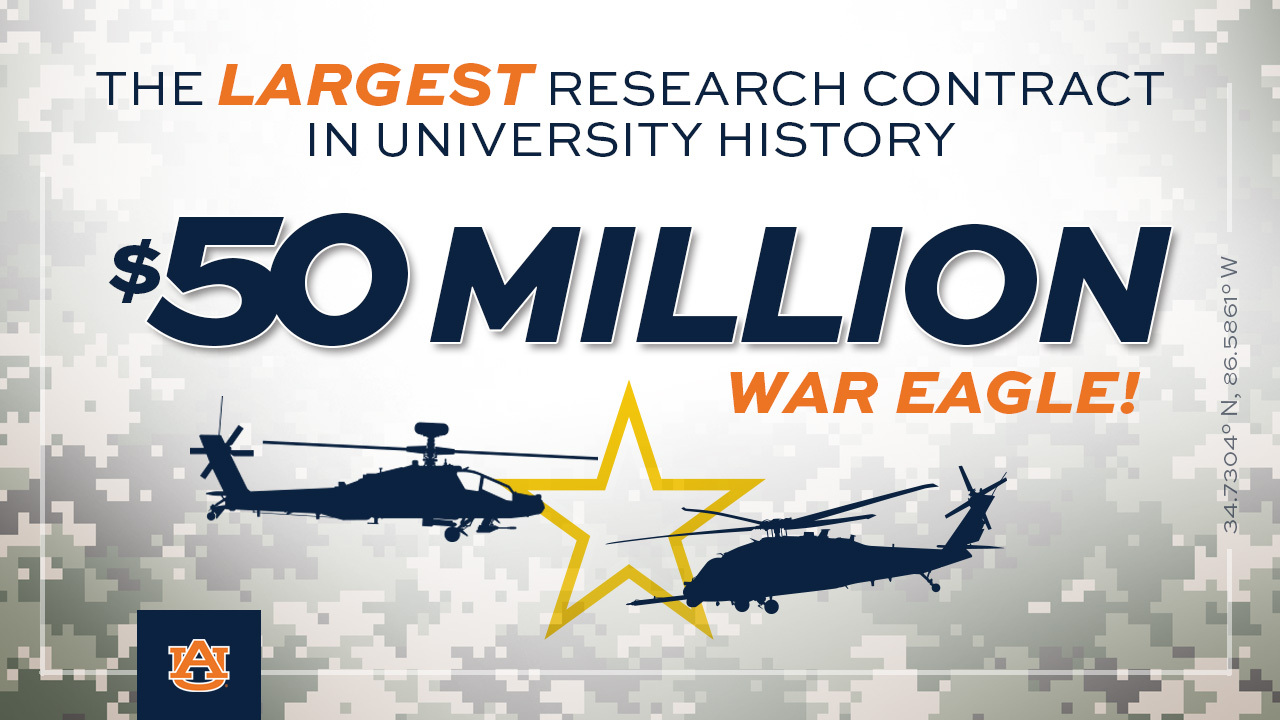
The single largest prime research contract ever awarded to Auburn University is designed to help the U.S. Army Combat Capabilities Development Command Aviation & Missile Center boost its increasing modernization efforts.
Categories: Manufacturing, Security, Engineering, External Engagement, Advanced Systems
Army invests another $4.35M in Auburn additive manufacturing qualification research
The U.S. Army is again asking Auburn University's National Center for Additive Manufacturing Excellence (NCAME) to help keep its caissons rolling toward the cutting edge.
In March 2022, NCAME initiated a $4.3 million Army project focused on the materials, parts and process qualification necessary for furthering implementation of additive manufacturing (AM) in Army operations, specifically those conducted by the Army’s Combat Capabilities Development Command Ground Vehicle Systems Center (DEVCOM GVSC). Few use-case scenarios for next-generation AM adoption illustrate the necessity of NCAME's qualification efforts better.
"The research being conducted here at Auburn is important to the Army because additive manufacturing is going to provide two different capabilities," Maj. Gen. Darren L. Werner, Special Assistant to the Commanding General for the United States Army Materiel Command, said during the Army Additive Manufacturing Summit hosted by the Samuel Ginn College of Engineering in 2021. "It's going to give us capability in our organic industrial base to integrate advanced manufacturing techniques, and it's also going to provide deployability of advanced manufacturing that we can potentially move into a forward location to produce and repair parts for our combat systems."
The Army's latest investment, a $4.35 million grant awarded this summer, will go toward establishing equivalency across multiple laser powder bed fusion (LPBF) printers — no easy task.
"Ensuring output consistency in a single AM machine is challenging enough," said NCAME director and project principal investigator Nima Shamsaei, Philpott-WestPoint Stevens Distinguished Professor of mechanical engineering. "Ensuring consistency and transferability of process output among different machines is something else. Though they may be utilized to produce the same part, different machines have different lasers, different powder delivery systems and different cooling characteristics, which may affect the part's performance."
For the Army's purposes, the equivalency challenges are even greater, Shamsaei said.
"Yes, the push towards integrating AM into the repair and maintenance of Army ground vehicles depends on consistency, repeatability, transferability and quality of manufactured parts, same as it does in other industries," he said. "But the scenarios we are talking about involve not just different machines but different depots across the globe. The idea is to be able to fabricate the same quality part regardless of location and regardless of the machine utilized."
Partnering on the project is the ASTM International Additive Manufacturing Center of Excellence (AM CoE), which will offer advisory services encompassing an assessment of the industry's current state of qualification and equivalency. The collaboration aims to produce an in-depth landscape analysis culminating in a strategic roadmap derived from the project's findings.
Co-principal investigator Shuai Shao, associate professor of mechanical engineering, believes that NCAME's approach to addressing the sorts of material variations in question, which Shamsaei has dubbed "AM's Achilles’ heel," is unique in the AM research arena.
"While one may focus only on aesthetic representation of mechanical properties, we try to establish equivalency at the structure level," Shao said. "We look for microstructure, porosity and surface texture and how these factors affect the mechanical properties. Eventually, the established equivalency will be validated using mechanical testing. Conventional approaches operate as if locking down the process will keep the structure in question the same. However, we have seen that the structure can be very sensitive to various factors including powder specification, process parameters, geometry, location on the build plate, to name a few."
In addition to significant experimentation, Shao said the project will incorporate simulation and data analytics, or machine learning.
"We're very focused on microstructural characterization because we believe equivalency should be established at that level and then validated through mechanical testing," Shamsaei said. "This approach to qualification will avoid fabrication and testing of hundreds of test specimens for each new machine and material combination. Our objective with this project is to continue developing a rapid and reliable approach for material and process qualification across different OEMs of metal LPBF equipment."
Media Contact: Jeremy Henderson, jdh0123@auburn.edu, 334-844-3591

Nima Shamsaei and Shuai Shao
Categories: Manufacturing, Transportation, Security, Engineering, External Engagement
Researchers in chemical engineering part of NSF-EPSCoR grant to reimagine sustainable development of plastic materials
Mismanaged micro- and nano-plastics can threaten the environment and health.
Three researchers in Auburn University’s Department of Chemical Engineering – Assistant Professor Symone Alexander, Department Chair Selen Cremaschi, and Associate Professor Zhihua Jiang – offer solutions that could reimagine the sustainable development of plastic materials, address plastic waste challenges and their climate/health impacts, and build community climate resilience while advancing social and environmental justice in Mississippi and Alabama.
Their multi-disciplinary study, “Advancing Social and Environmental Equity through Plastics Research: Education, Innovation and Inclusion” (ASPIRE), is a collaborative effort with researchers from the University of Southern Mississippi (led by professor Zhe Qiang), and part of a four-year, $4 million National Science Foundation (NSF)-Department of Energy Established Program to Stimulate Competitive Research (DOE EPSCoR) R-II Track-2 grant. EPSCoR R-II Track-2 grants are awarded to researchers looking to advance climate change research and resilience capacity to expand opportunities for disproportionately affected communities.
“We’ve heard of islands of trash in the ocean, but what we don't see are micro- and nano-plastics,” said Alexander, the Auburn’s principal investigator (PI). “Those are the very small particles that can easily be ingested by fish and marine animals, which we, as humans, ingest. This can lead to bio accumulation that can cause other health issues which aren't well studied.”
ASPIRE will develop advanced detection methods to analyze microplastic contamination in field and aquaculture samples, utilize novel methods to extend the lifespan and improve the performance of recycled products for sustained use, and design recyclable polymer thermosets using sustainable, bio-derived building blocks to establish chemistry-structure-property relationships.
“Think about our typical single-use plastics, that's your water bottles and fast-food containers… they're difficult to recycle because two of the materials used to make them (polyethylene and polypropylene) aren’t compatible,” Alexander said. “You can’t blend them back together but they're very difficult to separate. We want to make those materials compatible, so they have better, stronger properties.”
They also want to address the lack of recyclable materials known as thermosets, like rubber and epoxy, which cannot be melted and formed into new materials after use.
How? With dynamic compatibilizers and lignin, an organic polymer found in plants that Alexander considers, “the glue that holds cellulose together.” In this case, lignin can be used to hold materials – such as plastics – together.
“What we can do is use this lignin group as a linkage in typical thermoset polymers. I will extract lignin from agricultural waste streams. For example, we can use seed hulls from pecan shelling,” Alexander said. “In Alabama and Mississippi, shelling pecans is part of the agricultural industry and, typically, the seed hulls are thrown out. What we can do is use them to extract lignin and then incorporate that lignin as a dynamic linkage in these thermoset materials. It's taking a waste product and making it something valuable that can be purposed into materials.”
As a co-collaborator on the project, Cremaschi focuses on design optimization to assess economic feasibility and improve the competitiveness of the team’s proposed solutions.
“Our role – working with collaborators – is to perform a techno-economic analysis to assess competitiveness of our proposed solutions among each other and against existing technologies,” she said. “Once we have the models in place for simulation of the processes, then we quickly study different processes to improve the techno-economic competitiveness of our solutions.”
Jiang, director of the Alabama Center for Paper and Bioresource Engineering, will serve as Auburn’s senior personnel on the project and brings his vast understanding of lignin and experience in lignin separation to identify efficient lignin extraction processes.
Additional ASPIRE thrusts are technology transfer and educational components in Mississippi and Alabama.
“We will both be working with industry partners for technology transfer, but we also want to showcase the latest technologies for these coastal communities,” Alexander added, citing the Gulf Blue Initiative, a University of Southern Mississippi program which “pools the knowledge of research scientists, federal agencies, industry partners and entrepreneurs to further develop the region as a global leader in ocean- and maritime-related technologies.”
Alexander is excited to make an impact on industry, society, and health.
“Many of these health concerns affect people who look like me, or who come from a similar economic background,” she said. “They don't always receive the same level of rigorous filtration when it comes to treating drinking water, or when it comes to addressing the lack of employment. It's extremely important to me because communities that aren’t well served in terms of city planning, drinking water, or availability of resources suffer most from health impacts related to pollution. A large part of this project is leading more in-depth studies on the impact of plastic pollution on waterways and health of coastal communities in Mississippi and Alabama.
“On the materials and environmental side, in nature everything is used, and nothing is wasted. There's a process to recover, reuse, and reduce or minimize waste. As humans, we've gotten very comfortable with throwing things away after we use them once. We don't think about what happens when we're done. We need a system to recover, reuse and make a smaller impact on the environment.”
Media Contact: Joe McAdory, jem0040@auburn.edu, 334.844.3447

From left, Zhihua Jiang, the Auburn Pulp and Paper Associate Professor in chemical engineering, Symone Alexander, assistant professor in chemical engineering, and Selen Cremaschi, the B. Redd & Susan W. Redd Professor and chemical engineering chair.
Categories: Manufacturing, Energy & the Environment, Engineering
Chemical engineering researchers part of $23.8M project to reduce carbon dioxide emissions from paper mills
Selen Cremaschi, the B. Redd & Susan W. Redd Professor and chair of Auburn University’s Department of Chemical Engineering, and Zhihua Jiang, the Auburn Pulp and Paper Associate Professor in chemical engineering, are co-principal investigators of a $23.8 million study on carbon dioxide capture and storage, led by Blue Sky Infrastructure and funded by the U.S. Department of Energy.
The project, which Auburn will receive $635,000 of the total funding, is titled “Timberlands Sequestration – A Biomass Carbon Dioxide Capture and Removal Project at a Pulp Mill in Alabama.” It aims to develop biomass carbon capture and storage for the Alabama River Cellulose pulp and paper mill in Monroe County. It is the first study of its kind to be conducted on a larger scale at a pulp and paper mill in the U.S.
By leveraging their combined expertise in process systems engineering and a deep understanding of the pulp and paper industry, Cremaschi and Jiang will lead researchers in conducting extensive simulations, analyses and technical evaluations to develop innovative solutions for carbon dioxide reduction and propose cost-effective approaches to implement these solutions. The project’s interdisciplinary nature and emphasis on collaboration align with Auburn University’s commitment to research excellence and environmental stewardship.
“This project is a major step towards net zero emissions,” Cremaschi said. “Our research aims to capture and store carbon dioxide emissions from pulp and paper production sites, converting waste into valuable chemicals used internally for pulp and paper operations. By targeting carbon dioxide emissions from industrial operations and power generation, we have the opportunity to make a significant impact on reducing greenhouse gas emissions.”
Jiang, who also directs the Alabama Center for Paper and Bioresource Engineering, said this research could prove to be a gamechanger for carbon reduction.
“This project has the potential to become a practical and economically viable pathway for the pulp and paper industry to decarbonize their processes,” Jiang said. “This technology should be applicable to all pulp and paper mills and across a wide range of high-energy consumption manufacturing processes.”
Alabama River Cellulose mill is a long-time member of the Auburn Pulp and Paper Foundation (APPF), a leading organization that has strongly supported research and education in the pulp and paper program at Auburn University for more than 40 years. Supported by its member mills, the APPF fosters collaboration between academia and industry to promote sustainability and innovation in the field.
Media Contact: Joe McAdory, jem0040@auburn.edu, 334.844.3447
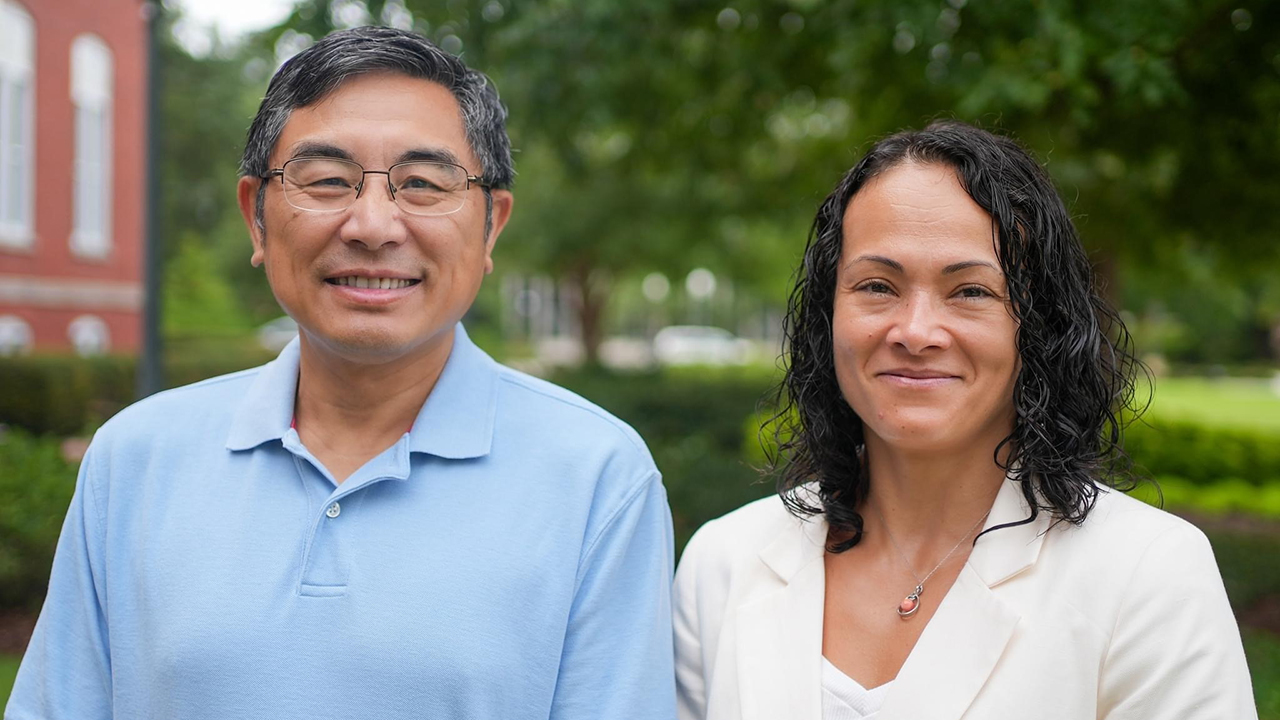
From left, Zhihua Jiang, the Auburn Pulp and Paper Associate Professor in chemical engineering, and Selen Cremaschi, the B. Redd & Susan W. Redd Professor and chemical engineering chair.
Categories: Manufacturing, Energy & the Environment, Engineering
Industrial and systems engineering assistant professor earns NSF CAREER Award for AM fatigue life prediction through deep learning
Four years ago, GE Aerospace transitioned to using additive manufacturing (AM) for their new Catalyst turboprop engine. Which meant that 800 traditionally manufactured components were consolidated into just 12 metal AM parts, the development cycle was dropped from 5-10 years to only two, the engine weight reduced by 5% and the fuel consumption improved by 1%. For G.E., that's a pretty big deal. If other U.S. aircraft manufacturers went the same route, that would be a pretty big deal for the planet.
There's a reason AM research across the globe is expected to push $24 billion by 2027, and the revolutionary impact on the aviation industry is one of them. Experts estimate that substantial adoption of 3D-printed parts could knock 200 million gallons off of annual aviation fuel consumption.
If the parts work.
Despite the demonstrated success of metal additive manufacturing in various industries, the performance uncertainty of AM parts undermines the potential of deploying AM for high-consequence applications. Air travel. Space travel. Those sorts of thing.
Which is why the National Science Foundation (NSF) is turning to assistant industrial and systems engineering professor Peter Liu in the form of a $500,000 CAREER Award meant to generate new insight into defect formation relevant to fatigue performance of parts manufactured through laser powder-bed fusion (LPBF) and uncover the synergistic impacts of multi-scale factors on fatigue fractures.
Liu hopes the five-year project, Deep Learning to Understand Fatigue Performance and Processing Relationship of Complex Parts by Additive Manufacturing for High-consequence Applications, "will establish a physics-centric, machine learning framework for fatigue life predictions, serving as a technological foundation for future metal AM production of dynamic load-bearing applications and establishment of a resilient and reconfigurable supply chain, and thus, enhance the competitiveness of U.S. industry.”
"The biggest challenges in fatigue performance assessment for LPBF parts come from the nonhomogeneous microstructural traits from process dynamics, coupled with their complex geometry and imposed multiaxial loading," he said. "Current fatigue performance assessment methods and tests are unable to take all these contributing factors into account."
Liu believes the best way to address those challenges is to combine fracture mechanics, finite element (FE) methods and novel data-driven models.
"The goal of this early career effort is to understand fatigue failures of complex LPBF parts under multiaxial loading for data-driven fatigue life predictions," he said. "The research will investigate the nature of fatigue failures from plastic deformation and crack initiation at the highest stress concentrations and translate fatigue life predictions into evaluating the crack growth at the vulnerable zones using a multiscale approach. Then we will develop new statistical models and a novel multiscale multifactorial deep learning model to incorporate crack growth and stress distribution to understand their impacts on fatigue performance and predict fatigue life."
Liu is also the principal investigator on another recent NSF project aimed at applying deep learning to AM development.
"My research passion is synergizing machine learning and fundamental process physics to advance manufacturing knowledge, efficiency, and capability of LPBF," Liu said. "I am extremely grateful to the support from my department, the college, the National Center for Additive Manufacturing Excellence (NCAME), the Interdisciplinary Center for Advanced Manufacturing Systems (ICAMS) and the AI@AU Initiative. This CAREER project aligns with one of the strategic areas of research in advanced manufacturing and materials at the Samuel Ginn College of Engineering. It will contribute to the leading research and education capabilities in advanced manufacturing at Auburn, accelerate AI applications in manufacturing, and increase interdisciplinary collaboration at Auburn."

Peter Liu, left, recently received an NSF CAREER award to support his research into deep learning's application in predicting fatigue performance in additive manufacturing.
Categories: Manufacturing, Transportation, Engineering, Advanced Systems
Auburn University signs memorandum of understanding with KITECH to expand research efforts
Auburn University President Christopher B. Roberts signed a memorandum of understanding, or MOU, on Tuesday, Dec. 6, with Nak Kyu Lee, president of the Korea Institute of Technology, or KITECH, that will expand upon the collaborative research efforts of Auburn’s faculty and laboratories with local companies supported by KITECH.
Building on the signed MOU between the organizations in 2015, this newly expanded agreement includes the establishment of research and/or automotive technology support offices and laboratories, the creation of joint research projects and the exchange of technical information, periodic training symposia and consulting.
“As a land-grant university, Auburn aspires to deliver real-world, practical solutions,” Roberts said while addressing administrators and dignitaries at the ceremonial event held at The Hotel at Auburn University and Dixon Conference Center. “Through joint research efforts and projects, we can anticipate and meet the distinct needs of the automotive manufacturers and suppliers along the I-85 corridor that have strongly impacted our region’s economic climate. This partnership demonstrates an interchange of education, research and service, with global implications.”
The agreement spelled out a number of desired outcomes:
-
Establishment of research and/or automotive technology support offices and laboratories
-
Exchange of scientific/technical research materials, publications, information and advice
-
Development of mutually agreed-upon collaborative research projects
-
Identification of technical barriers encountered and improvement needed by manufacturers
-
Provision of technical solutions using means and technologies available at both institutions
-
Creation of joint research projects to identify funding opportunities through governmental agencies; and
-
Organization of periodic symposia on manufacturing technologies and related subjects
As identified by Roberts, the I-85 corridor remains a hotbed for automobile suppliers. KIA’s 2,200-acre plant in nearby West Point, Georgia, produces more than 300,000 automobiles per year. Hyundai’s 3.4 billion-square-foot plant just south of Montgomery, Alabama, is capable of producing nearly 400,000 vehicles per year.
“The Auburn-Opelika metropolitan area is an optimal region for joint research between academia and industry in the automobile field,” said Lee, whose institution is an application-oriented research institute founded with the mission to support the industry sector, especially the innovation of small- to mid-sized enterprises. “We plan to embark on joint research with Auburn University on innovative manufacturing technology. We also plan to answer to the demands of parts manufacturers in the region by utilizing the infrastructure and other means available at both institutions.”
Auburn University Outreach will manage the current initiative and coordinate the details of the memorandum of understanding. Since 2015, the Office of Professional and Continuing Education, a unit of University Outreach, and the Samuel Ginn College of Engineering have worked closely with KITECH on projects, including the “Korea US Automotive Technology Workshop” and various technology support and research projects.
“It is a great pleasure to not only continue this collaborative endeavor, but to expand upon it for the betterment of our stakeholders, community members and economic outlook,” said Royrickers Cook, Auburn University vice president for University Outreach and associate provost. The relationship between Auburn University and KITECH is longstanding, and we in University Outreach and the Office of Professional and Continuing Education are proud to be a part of this impactful collaboration.
“As we embark upon emerging electronic vehicle technologies, the expanded partnership positions each of us at the forefront of innovation, technological research and the promotion of economic development in the state of Alabama and beyond. KITECH’s values align well with Auburn’s land-grant mission of Outreach and help us carry out our responsibility to transform research into services that meet our communities’ most critical needs.”
Auburn University, recognized as a Carnegie R1 research institution, continues to cultivate the growing role that research and collaboration has played in improving business practices, finding new solutions to old problems and improving the quality of lives for thousands.
“In addition to advancing Auburn’s land-grant mission, this partnership demonstrates the value of strategic international and institutional engagements to the economic development of our state,” said Jim Weyhenmeyer, vice president for research and economic development. “Through this partnership with KITECH, we will continue strengthening Auburn’s capacity to lead automotive technology research and development, particularly in the global market.”
In the spirit of intellectual symposia following the signing ceremony, Auburn University and KITECH thought leaders combined to produce the first “KITECH-Auburn University Manufacturing Innovation Technology Forum.”
Larry Rilett, director of the Auburn University Transportation Research Institute within the Samuel Ginn College of Engineering, discussed “Opportunities and Challenges for Electric Vehicle Adoption: The Alabama Perspective.”
Mark Hoffman, assistant professor of mechanical engineering in the Samuel Ginn College of Engineering, discussed “Mobile Industry Status and Challenges.”
Flexing KITECH’s academic muscle, KITECH’s Sungwook Kang presented “Friction Stir Welding for EV Parts Manufacturing.”
Rilett, Hoffman and Kang were then joined by Dong Woo “Daniel” Yu, assistant director of Outreach Programs within the Office of Professional and Continuing Education for a 35-minute panel discussion.
Yu will coordinate details of the joint efforts between KITECH and Auburn University.
“Since the initial agreement was signed in 2015, I’ve been able to work with many Korean manufacturers to assess their technical problems, needs and provide training,” said Yu. “Having the opportunity to extend the resources from both Auburn University and KITECH has allowed us to assist several manufacturers. We’ll continue these joints efforts on a broader scope as we move forward, especially in the areas of emerging EV production technologies.”
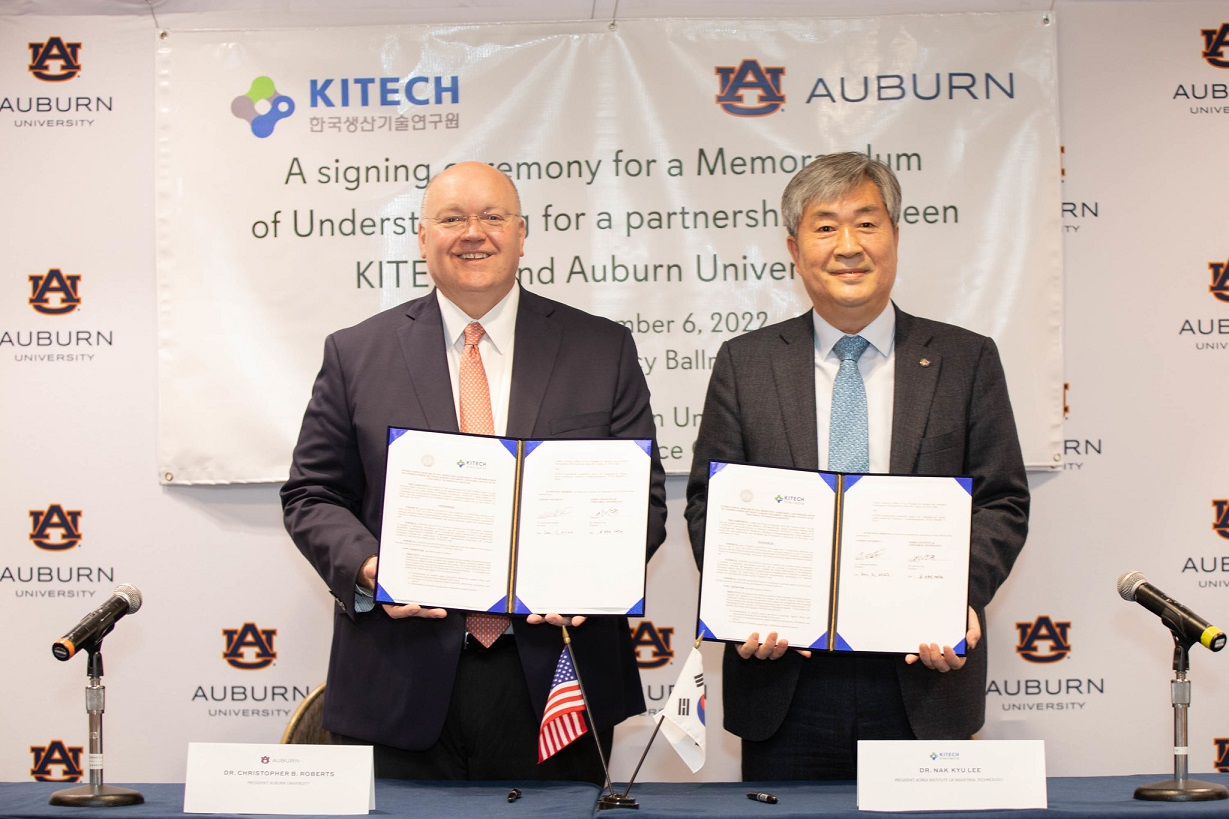
Auburn University President Christopher B. Roberts, left, signed a memorandum of understanding on Tuesday, Dec. 6, with Nak Kyu Lee, president of the Korea Institute of Technology, that will expand upon the collaborative research efforts of Auburn’s faculty and laboratories with local companies supported by KITECH.
Categories: Manufacturing, Transportation, External Engagement, Advanced Systems
NIST awards Auburn nearly $1M to lead NDE-based additive manufacturing qualification via data analytics
The National Institute of Standards and Technology (NIST) recently awarded Auburn University's National Center for Additive Manufacturing Excellence (NCAME) and the ASTM Additive Manufacturing Center of Excellence (AM CoE) nearly $1 million to establish through computer vision and machine learning a data-driven framework for the non-destructive qualification of additively manufactured materials and parts for mission critical applications.
The framework will allow for the rapid identification of critical defects and the prediction of fatigue performance with non-destructive evaluation (NDE) data.
"Additive manufacturing (AM) has gained significant attention from key industrial sectors including aerospace, defense, automotive, and medical due to its unique capability of fabricating customized parts with complex geometries on demand," said NCAME director Nima Shamsaei, Philpott-WestPoint Stevens Distinguished Professor of mechanical engineering. "However, current AM platforms are still prone to producing parts with varying degrees of defects detrimental to the parts’ structural integrity, specifically in fatigue critical applications."
NDE-based and prediction-based qualifications are key to expedited adoption of AM, said Shuai Shao, associate mechanical engineering professor.
"Conventional qualification approaches are challenging when directly applied to AM due to the parts' defect content being sensitive to many process parameters," Shao said.
Shamsaei is the project's principal investigator (PI). Co-PIs from Auburn are Shao and assistant industrial and systems professor Peter Liu; Co-PIs from ASTM International are Mohsen Seifi, Mahdi Jamshidinia and Aaron McCandless .
"Extracting defect features with computer vision and correlating them with fatigue performance using machine learning, are the main ingredient of the proposed NDE-based qualification framework." Liu said.
Established in 2017 through a public-private partnership between Auburn and NASA, NCAME has built one of the world's most robust environments for framework-based analysis of fatigue performance towards qualification and certification of additively manufactured materials and parts. For example, NCAME has been conducting research for the Federal Aviation Administration (FAA) on matters affecting the AM qualification and certification, specifically in fatigue-critical applications.
This most recent award reflects NIST's continuing efforts to address barriers to AM adoption through measurement science supporting equivalence-based qualification and model-based qualification, the characterization of materials, and standards to support consistent data exchange and characterize new advances in AM production systems.
Over the course of the two-year project, NCAME and ASTM AM CoE researchers will also work with NIST scientists to explore ways to incorporate their findings into data management systems like NIST’s Additive Manufacturing Materials Database (AMMD) as well as potential pathways for standardization needs.
"Research need in this area is extremely timely and important," said Seifi, ASTM International’s vice president of Global Advanced Manufacturing.
Formed in 2018, the ASTM AM CoE aims to accelerate the development and adoption of AM by supporting standardization, developing training and certification programs, and providing market intelligence, business strategy and advisory services.
"The goal of this NIST funded project is well-aligned with the mission of the newly established AM CoE Consortium for Materials Data and Standardization (CMDS) with members representing the entire AM value chain," Seifi said.
Media Contact: Jeremy Henderson, jdh0123@auburn.edu, 334-844-3591
BY JEREMY HENDERSON
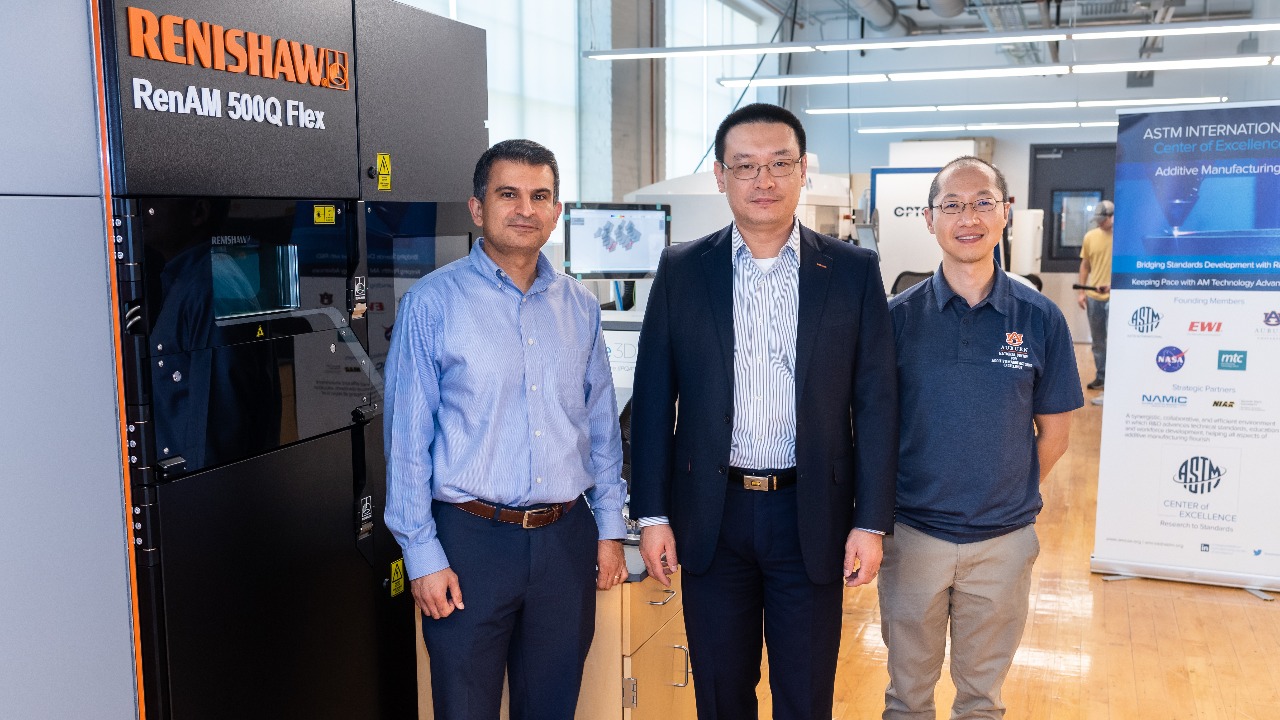
Nima Shamsaei, Shuai Shao and Peter Liu
Categories: Manufacturing, Engineering, Advanced Systems
Auburn showcases variety of university-developed technologies at BIO Alabama conference
Auburn University recently participated in the BIO Alabama conference at the Grand Bohemian Hotel in Mountain Brook, showcasing seven of its biotechnology research developments.
BIO Alabama is the trade organization for the state’s biosciences industry. This year’s event—the first meeting following a six-year hiatus due in part to the COVID-19 pandemic—featured approximately 200 scientists and their research developments April 25-26.
Melinda Richter, global head of Innovation at Johnson & Johnson, served as keynote speaker under this year’s theme, “Building Alabama’s Biohorizons,” focusing on the future of the industry’s participation in Alabama’s innovation economy.
Auburn’s presentations included:
-
Vivosphere cell encapsulation technology platform for drug development and discovery (Elizabeth Lipke; presented by co-inventor Yuan Tian) – This is a 3D cell encapsulation method and device for more accurate and cost-effective drug screening, bioinks and regenerative medicine.
-
Anti-cancer immunotherapy targeting CD47 (James Gillespie, joint project with VCOM) – Development of an anticancer treatment that could replace immunomodulatory therapies targeting CD47.
-
Computational tool for speeding discovery of natural beneficial compounds (Angela Calderon and Cheryl Seals; presented by Kabre Heck and Muhammad Gulfam) – A collaborative project about an automated method to analyze mass spectrometry data to identify potential bioactive compounds in complex mixtures.
-
Engineered bacteria for producing biofuels and other compounds (Yi Wang) – Engineering of bacteria to express record levels of butanol for biofuel or other industrial applications or to express record levels of butyl acetate for use in foods, consumer goods or industrial processes.
-
Computationally designed compounds for treating Alzheimer’s disease (Raj Amin; presented by Ian Steinke and Fajar Wibowo) – A custom-designed therapeutic compound for treating Alzheimer’s without the side effects seen with other drugs in this class.
-
Gene therapy vectors for therapeutic treatment of neurological disease (Doug Martin) – Engineered AAV vectors for treating neurological diseases such as rabies.
-
Medical device for improving diagnosis and monitoring of neuropathy in diabetic patients (Michael Zabala and Thomas Burch; presented by co-inventor Kenny Brock, VCOM) – A medical device for accurately monitoring and measuring loss of feeling in diabetic patients. (Jon Commander is also a co-inventor and is with VCOM.)
BIO Alabama is the leading advocate for Alabama's bioeconomy. The organization represents the state on a national and international stage, promoting the intellectual and innovative capital to make Alabama a premier place to invest, start and grow in bioscience.
Alabama’s bioscience industry provides a $7.3 billion impact on the state’s economy, according to BIO Alabama data. Auburn has participated in BIO Alabama events for a number of years.
"As presenting sponsor for this year’s BIO Alabama conference, Auburn University had an important opportunity to showcase some of our latest technologies during a reverse-pitch session to industry,” said Bill Dean, executive director of the Auburn Research and Technology Foundation.
“Auburn’s participation in events like the BIO Alabama conference speaks to our role in growing the region’s bioeconomy and demonstrates our commitment to the bio-sector in the form of industry collaboration and partnerships that will advance research and impact quality of life throughout the state.”
BY MITCH EMMONS
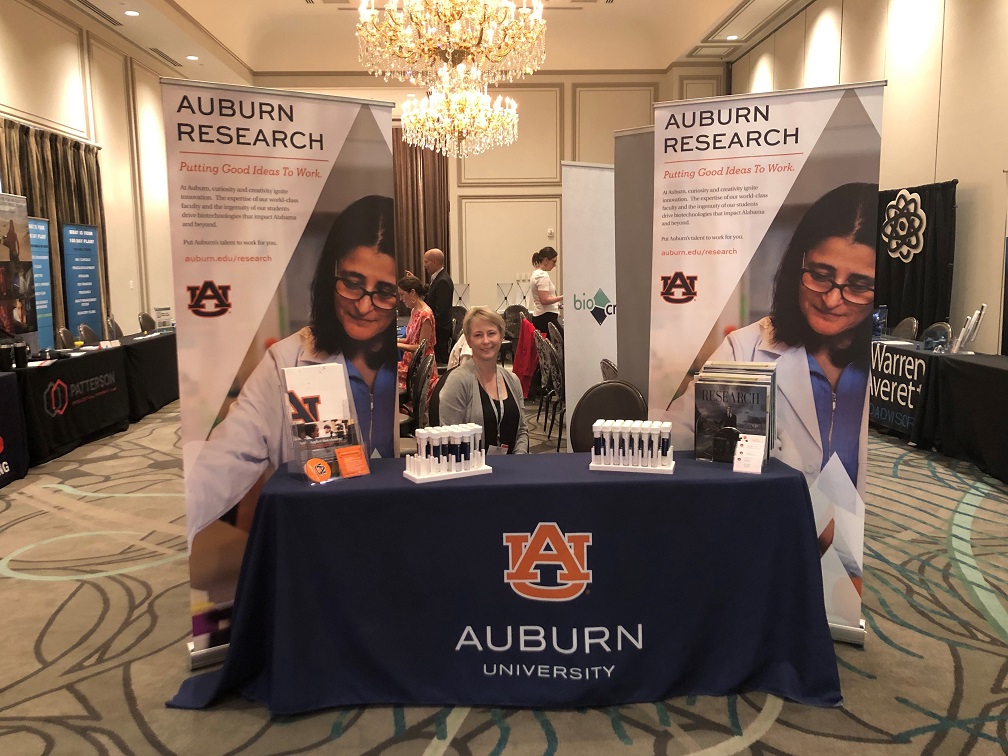
Liz Smith, College of Agriculture academic advisor, works at Auburn’s booth during the BIO Alabama conference. She talked with companies about opportunities for applied biotechnology graduates.
Categories: Manufacturing, Energy & the Environment, Health Sciences, Food Systems, Engineering, Life Sciences, Agriculture
Aerospace engineering study encourages face mask redesign in the future
The COVID-19 pandemic brought about the use of face masks as a means of reducing the airborne transmission of diseases to the center of attention of people around the world. Researchers in aerospace engineering at Auburn University's Samuel Ginn College of Engineering are leading a study that will help improve our understanding of the science that can be expected to guide the design and use of masks in different situations and environments moving forward.
Their research has found that while basic surgical masks offer a first line of defense to both the wearer and the people around them, they are not foolproof as flow leakage occurs around the mask and their effectiveness under realistic coughing conditions is not known.
Assistant Professor Vrishank Raghav, Sarah Morris, a postdoctoral research fellow, and William McAtee, a graduate research assistant, found that repetitive ‘pulsatile’ coughs allow expiratory particles to escape through a surgical mask’s sides and above the nose in their co-authored paper, “Influence of expiratory flow pulsatility on the effectiveness of a surgical mask.”
Smoke from Gloria, a mannequin designed by Auburn's Applied Fluids Research Group, shows where basic surgical mask leakage can occur during a cough.
The study – part of a $464,846 National Science Foundation grant in collaboration with the University of Michigan funded in 2021 – was published as an invited article by the Journal of Exposure Science & Environmental Epidemiology, a Nature publication.
“Our research has found that if you are wearing a mask and you cough, the volume of air that leaks is reduced compared to not wearing a mask,” Morris said.
“However, the effect of pulsatility does influence the leakage volume and must be considered when this is modelled.”
Raghav said the source of the problem with basic surgical masks — the blue devices most-commonly sold to and used by the public during the COVID-19 pandemic — is pre-loosening as inhaling, exhaling, double, or even triple coughs provide gaps for germs to become airborne.
Laser imaging and high-speed photography were utilized to show mask leakage during simulated coughs on the top of the mask, above, and the sides of the mask, below.
“The main reason why surgical masks move, and open gaps, is because the air you are breathing in and out cannot easily travel through the tiny pores of the mask,” said Raghav, a recent NSF CAREER Award recipient. “Instead, it slowly pushes the mask out of the way and when you cough, air finds the path of least resistance out of the mask, which is outside the cheeks and above the nose.”
Raghav agreed that masks of higher quality than basic surgical masks can, if worn correctly, provide better protection. “Surgical masks allow significantly more protection than wearing no mask at all, cutting out roughly 85 percent of the expiratory flow,” he said. “Of course, N95s fit tighter, are secure and allow only a fraction of expired air to leak. Further innovations will be required before surgical masks are as effective as N95s.”
Raghav, Morris and McAtee utilized laser imaging, high-speed photography and a coughing simulator to determine surgical mask leakage. This wasn’t any coughing simulator. It was a custom-built mannequin named Gloria – decked out in a blue surgical mask – designed within Auburn’s Applied Fluids Research Group laboratory.
Using the device, a computer-controlled solenoid valve provides desired air flow rates by controlling a pressurized air source at the wall. From there, a pipe ‘throat’ inserted through the mannequin allows air flow from the wall to a one-inch diameter mouth, which is met by the surgical mask.
“We have a computerized control valve that opens and closes to let the air in and out. We control the pulsatility of the air,” Morris said. “We can create a single pulse, a double pulse, or a triple pulse.”
Two main techniques are used to make leakage measurements – flow visualization and particle image velocimetry. With flow visualization – the long pipe carries smoke with two-micron fog particles. When the mannequin coughs, smoke will follow the flow field. A Nikon mirrorless camera is used to capture the expiratory flow — leakage made visible by smoke.
Particle image velocimetry is where laser imaging comes into play.
“This is a quantitative measurement technique where we have these tiny, two-micron particles (representing leaked air) that follow the flow, and we are taking high-speed photos of them,” Morris said. “If we take images at pre-determined times apart, we can actually see where those particles are moving between image one and image two.”
A pulsed, high-speed laser combined with a laser arm and light sheet generating optics illuminates the 2D field of view, providing revealing imagery.
Though mask mandates have currently evaporated in many locations, Raghav pointed out that masks can continue to be useful in many settings.
BY JOE McADORY
Media Contact: Joe McAdory, jem0040@auburn.edu, 334.844.3447
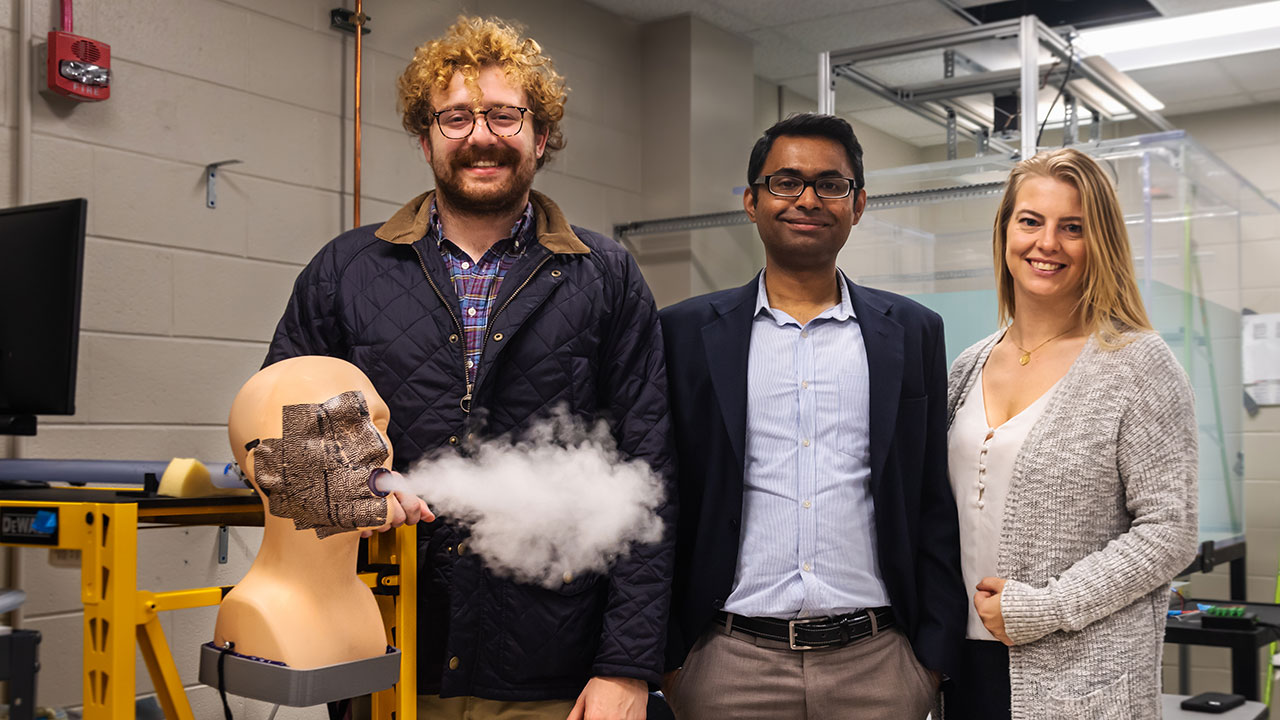
Researchers, from left, William McAtee, assistant professor Vrishank Raghav, and Sarah Morris, used 'Gloria', a mannequin created by the Applied Fluids Research Group, to serve as a pulsatile coughing simulator.
Categories: Manufacturing, Health Sciences, Engineering
Army invests $4.3 million in Auburn University additive manufacturing research
The U.S. Army has asked Auburn University to help build the future of American combat readiness.
Through a recent $4.3 million Army grant, the National Center for Additive Manufacturing Excellence (NCAME) at Auburn University will soon initiate a two-year project focused on materials, parts and process qualification, all of which are necessary for furthering the adoption and implementation of additive manufacturing in Army operations.
"Material variation is what I call the ‘Achilles heel’ of additive manufacturing," said NCAME director and project principal investigator Nima Shamsaei, Philpott-WestPoint Stevens Distinguished Professor of mechanical engineering. "It can make the qualification and certification of additively manufactured materials and parts challenging."
Even more challenging, Shamsaei said, is ensuring the consistency and transferability of process output among different additive manufacturing machines, a project goal that NCAME researchers hope to achieve not only with exhaustive mechanical testing but with AI — machine learning, specifically.
"Machine learning will help us establish structure-property relationships in a much more comprehensive way, which is somewhat transferable among platforms," said co-principal investigator and assistant mechanical engineering professor Elham Mirkoohi.
Shamsaei says Mirkoohi’s experience in AI and machine learning applications for additive manufacturing is the newest addition to NCAME’s research repertoire, which continues to draw high-profile government research grants.
"Simulation and machine learning are effective tools to understand the role of microstructure and defects on mechanical properties,” said co-principal investigator Shuai Shao, associate professor of mechanical engineering.
That understanding can help establish equivalency with less need for extensive experimentation, Shao said.
"This project not only looks into innovative ways to generate materials data, but also emphasizes on transferring the knowledge among different additive platforms by means of establishing equivalency," said co-principal investigator Masoud Mahjouri-Samani, assistant professor of electrical and computer engineering.
Aaron LaLonde, who as technical specialist for the U.S. Army DEVCOM Ground Vehicle Systems Center, helped facilitate the Army grant, believes the project will be crucial for further integrating AM into the Army’s modernization and sustainment efforts.
"NCAME,” LaLonde said, “has become one of the main key players in additive research along these lines.”
His comments echo those of Maj. Gen. Darren L. Werner, commanding general of the U.S. Army Tank-automotive and Armaments Command (TACOM), during the Army Additive Manufacturing Summit hosted by the Samuel Ginn College of Engineering last June.
"The research being conducted here at Auburn is important to the Army because additive manufacturing is going to provide two different capabilities," Werner said. "It's going to give us capability in our organic industrial base to integrate advanced manufacturing techniques, and it's also going to provide deployability of advanced manufacturing that we can potentially move into a forward location to produce and repair parts for our combat systems."
Established in 2017 through a public-private partnership between Auburn and NASA, NCAME is also one of the founding partners of the ASTM International Additive Manufacturing Center of Excellence (ASTM AM CoE), which aims to close additive manufacturing standards and workforce gaps.
The FAA also recently awarded NCAME $6 million for research toward improving commercial air travel through the use of additively manufactured metal components focused on a commonly used materials in aviation and space, titanium alloys.
Media Contact: Jeremy Henderson, jdh0123@auburn.edu, 334-844-2224
BY JEREMY HENDERSON
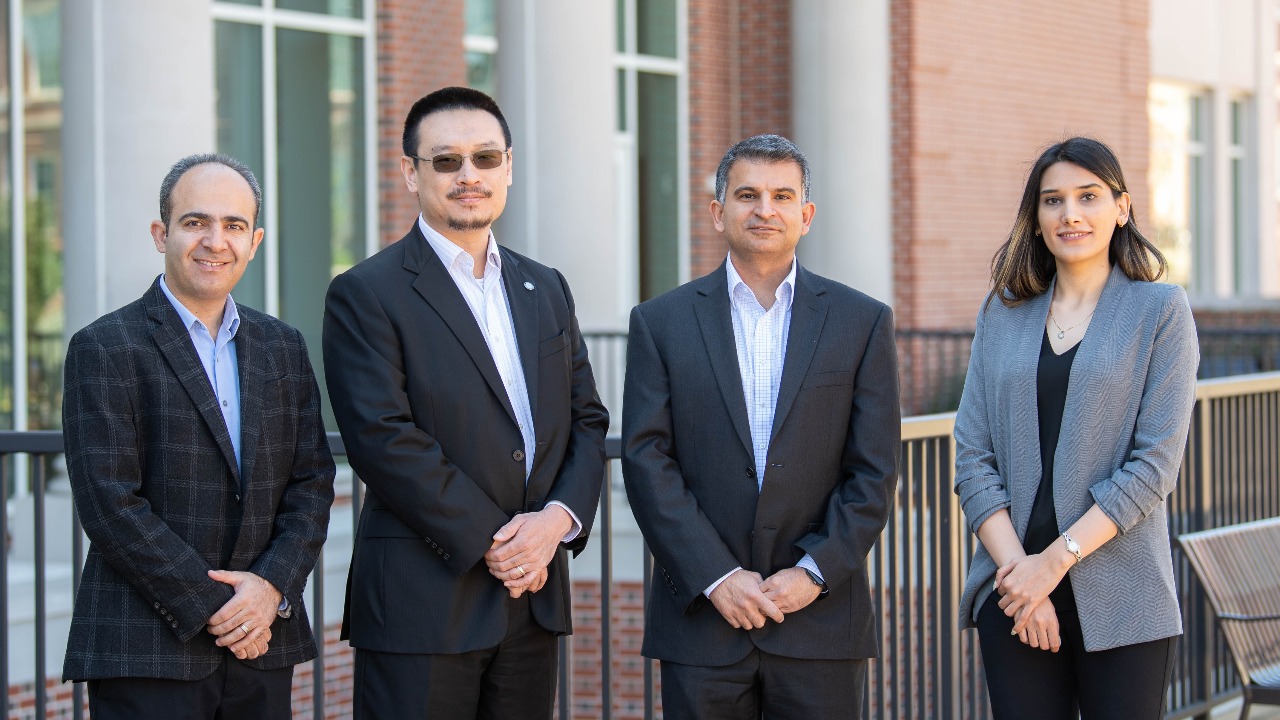
Co-principal investigators, pictured from left to right, are professors Masoud Mahjouri-Samani, Shuai Shao, Nima Shamsaei and Elham Mirkoohi.
Categories: Manufacturing, Engineering, Advanced Systems
Entomology professor researching clothing materials designed to prevent mosquito bites
So, imagine you’re a female mosquito.
You’re patiently circling, waiting to pounce, while your unsuspecting victim enjoys a picnic with no idea they have unknowingly been placed on your menu. Your multi-lensed eyes have confirmed what your carbon dioxide-detecting and thermal-imaging sensory organs first alerted you to—a likely meal—and although your intended entree is wearing long sleeves, your proboscis, or mouth parts, include six razor-sharp, needle-like appendages that can easily penetrate the tiny spaces in the shirt’s weave.
A perfectly designed biting machine, you close in and stealthily alight on your target’s shoulder, plunging those bloodsucking daggers downward like you’ve done so many times before. But this time they bounce off the sleeve harmlessly. You try and try again, more frantically each time, but the unique weave of the fabric foils your bite and ruins your evening dinner plans. Frustrated, slightly bewildered, and with a noticeably bent proboscis, you drunkenly take flight to look for an easier meal. This time, man beats mosquito.
That’s the kind of “Bug’s Life” scenario that a team led by John Beckmann, assistant professor of entomology and plant pathology in Auburn University’s College of Agriculture, hopes to make an everyday occurrence through the development of a lightweight fabric that blocks mosquito bites while also being cool enough to wear during hot and humid weather.
Beckmann’s team includes students Alexa England, Kyle Oswalt, Natalie Wong, Richard Murphy and Bryan Holt, along with collaborator Jim McCann at Carnegie Mellon University. Their work was recently awarded an $868,145 grant from the Alabama Department of Economic and Community Affairs, or ADECA, one of three grants made to Auburn professors totaling $1.31 million overall.
Beckmann first came up with the idea of bite-proof clothing while brainstorming possible research projects in his back yard, although he swears it wasn’t a mosquito bite that inspired him. He did recall, however, an earlier Minnesota camping trip where deer flies bit him repeatedly through a heavyweight, long-sleeved shirt. That convinced him his idea was potentially useful, but the first step for him and his team was making sure that available “mosquito-proof” clothing wasn’t already doing the job.
Most bite-resistant clothing currently on the market is either impregnated with pesticide or made with thick, non-breathable fabrics that are both hot to wear, yet still easy for the insects to overcome. Another alternative is to cover oneself from head to toe in regular clothing, but even that gives a false sense of security.
“People say, ‘wear long sleeves’ a lot,” Beckmann explained. “But long sleeves don’t block mosquitos. There are also several companies out there that claim their fabrics resist bites, but we tested them and they really don’t. They’ve never solved the issue of the holes in the makeup of their fabrics, which allow the mosquitos to penetrate them.”
Beckmann says the vulnerability of current textiles lies in the weaving method, which leaves gaps the mosquitos can easily exploit.
“Clothing is constructed by taking a linear fiber and essentially weaving it over another fiber, or by looping loops, as in knitting,” he said. “Both these processes leave microscopic holes. It’s hard to see them with the naked eye, but if you hold your clothes up to the sun, you’ll see how much light shines through. Every one of those holes is far larger than the mosquito’s proboscis. So it’s actually very easy for them to bite through even supposedly mosquito-resistant clothing.”
Since they tested various shirts currently advertised as mosquito-proof by wearing them and sticking their arms into a tank full of the hungry mosquitos, Beckmann and his team know more than they want to about bites. Research can sometimes itch. But while the solution to the problem seems simple—find a way to eliminate the holes, or at least make them smaller than a mosquito’s proboscis—that’s easier said than done. Because not only is the Auburn group trying to design clothing that will resist bites, they are also trying to make that clothing cool and comfortable, which traditionally has meant using a breathable material that will allow air to circulate. And fabric breathability has always required holes.
“That is the precise reason why this project is not as easy as people think,” Beckmann noted. “You obviously need your clothes to be breathable. Paradoxically, that usually comes at the cost of letting mosquitos bite through them. So the basic problem is keeping the holes there while simultaneously sealing them off from microscopic mosquito mouth parts.”
A key to solving this paradox is the team’s acquisition of a CNC, or computer numerical control, knitting machine—thanks in part to the ADECA grant—that provides the ability to produce textiles at a very fine level of resolution. In comparison to traditional weaving, these so-called “weft-knitting” machines build textiles by interconnecting loops of yarn in a horizontal fashion. The result is multiple interconnected layers within a single seamless fabric, and the process is often referred to as “3D knitting.” With the added ability to use multiple types of yarn, CNC machines allow the fabrication of a much greater range of textile types and provide many more options of structural geometry.
“Alabama used to be a big source of textile manufacturing and research, and Auburn was a major part of that.” Beckmann said, “But over the last few decades, much of that manufacturing went overseas, and Alabama lost its place in the textile industry. The ADECA grant is to some degree attempting to help restore that place by establishing this knitting laboratory in Auburn. We want to do more with what we were given and bring Alabama back as a textile innovator and manufacturer.
“Another important thing to emphasize about the knitting lab,” he added, “is that we are looking for collaborations. There are applications in engineering, aerospace, fashion, art, entomology, agriculture and many other areas. With this CNC machine knitting and the ability to twist our own fibers, we are certainly capable of more than just mosquito-resistant textiles. We can potentially help with any textile research or with trying to make new textiles from novel inputs. So we are open for business, and anyone who wants to collaborate should directly contact me.”
For now, however, the first challenge for the new lab is mosquito-defeating apparel. While other researchers are working on that same problem, Beckmann says there is room for many potential solutions.
“Textiles are very complex and there are many variables that go into constructing them,” he said. “You can generate almost infinite iterations, and in that search space of theoretical textiles, some of those iterations will block mosquito bites and some won’t. And some of those materials will be comfortable and others won’t.
“It’s all about finding the best combinations,” he added. “Obviously, there are different brands of shoes, cars, etc. So there is room for more innovation. We hope to contribute to the field and generate the best product. With a few good minds contributing independently, the problem should get solved one way or another. That’s how science works.”
Beckmann and his team are also testing their results against a variety of mosquito species—hoping for a “one size fits all” approach than can resist multiple types. In the U.S. alone that means 176 different known species, while there are more than 3,000 species worldwide.
“What we hope to do is generate a product that blocks multiple mosquitos, not only the most common Aedes, Culex and Anopheles species,” Beckmann said. “But this has to be tested, and it’s one area that has not been tested enough. It is one definitive reason why what we are doing is different from other researchers. We are trying to explore all the worst mosquitos, and not just the easiest ones to culture.”
After a year of testing and gathering data, Beckmann and his team have developed a fabric that foils mosquitos with help from roboticist McCann at Carnegie Mellon, a researcher who programs knitting robots. But it is not yet as comfortable as they would like. The next step is to make it more breathable and cooler to wear.
“Think of it as athletic apparel that blocks mosquito bites,” Beckmann said. “The knitting machine lab is what allows us to try different methods of manufacturing. In the end, clothes have to be mass-manufactured. So you have to find a solution to the problem that is scalable. And that is what the knitting machines allow us to explore.”
Eventually, Beckmann hopes to repay ADECA’s investment in the idea many times over by developing a product that can be made in Alabama, bringing new industry and jobs to the state.
“We hope to manufacture our product in state,” he said, “and we are already talking to business collaborators within Alabama to begin setting up that process. But we have a long road still ahead.”
But if Beckmann and his Auburn team succeed, it will be a sweet—and notably bloodless—victory in the long, ongoing war between people and mosquitos. Enjoying the outdoors without fighting off hordes of the hungry, biting insects will be as easy as slipping on the right clothing, and that clothing will hopefully be made in Alabama.
The only real losers will be the mosquitos. For once, being a mosquito will bite in a whole new way.
BY MIKE JERNIGAN
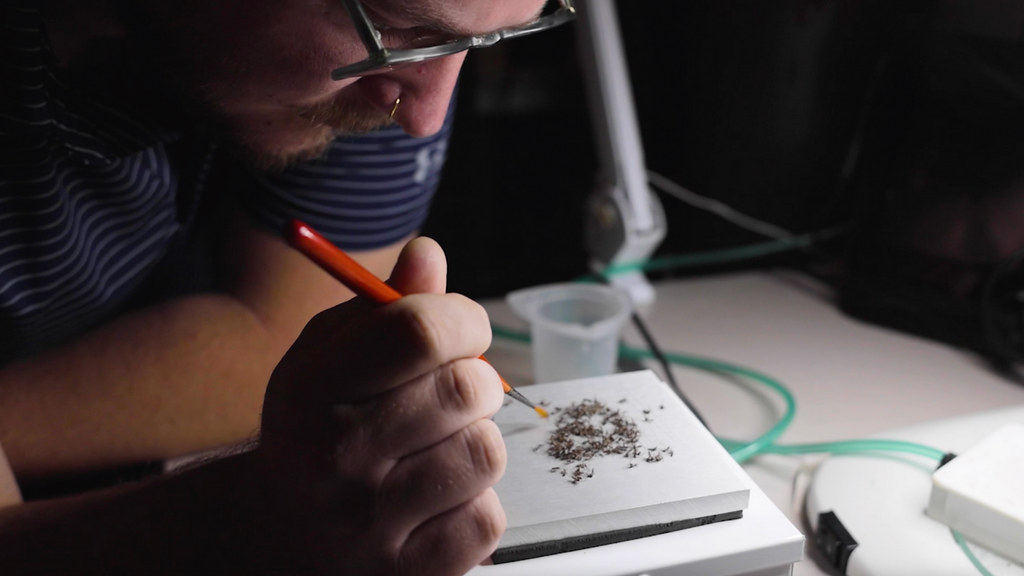
John Beckmann, Auburn University assistant professor of entomology and plant pathology, examines mosquitos as part of his research on material to block mosquito bites.
Categories: Manufacturing, Agriculture, Graduate Student Research
Auburn University ranks among top U.S. research institutions in National Science Foundation survey
Auburn University is ranked in the top 11% of U.S. research institutions, coming in at No. 100 among 915 universities, according to the National Science Foundation’s recent Higher Education Research and Development, or HERD, Survey. Among public universities, Auburn is ranked No. 67 out of 415 institutions.
“Auburn’s ranking among the nation’s top 100 research institutions is a significant accomplishment,” said James Weyhenmeyer, Auburn vice president for Research and Economic Development. “Our innovative researchers have remained committed to engaging in impactful research even during the challenges of a global pandemic. Their dedication and ingenuity are reflected in Auburn’s rise in the rankings.”
The annual survey, compiled from fiscal year 2020 research expenditures, saw Auburn climb five spots from the previous year.
During the five-year period of 2016-20, Auburn’s annual research expenditures increased from $152.4 million to $255.3 million, resulting in a rankings jump of 26 places. Among Southeastern Conference universities, Auburn had the highest percentage increase in research expenditures over that time period: a jump of 67.5%.
For universities without a medical school, Auburn ranked No. 61 nationally and No. 1 in the state. Auburn also was highly ranked nationally in a number of specific fields of research, including No. 54 in engineering, No. 54 in mathematics and statistics and No. 93 in physical sciences, all tops in the state.
A hallmark of Auburn’s research is the diversity of its funded projects. Highlights include:
- The Samuel Ginn College of Engineering’s National Center for Additive Manufacturing Excellence is working with NASA under a $14.6 million contract to develop additive manufacturing processes for improving the performance of liquid rocket engines. The center also is using $6 million from the Federal Aviation Administration to advance the use of additive manufacturing in commercial aviation.
- The state of Alabama recently awarded Auburn $1.6 million for four sustainability projects: advanced jet and diesel fuels from woody biomass grown in the state and from waste plastics; biotechnology that enables conversion of organic wastes into bioplastics; 3D printable polymer smart machines, such as actuators, sensors and energy harvesters; and a new, high-value aquaculture feed binder made from soybean hulls.
- The National Institutes of Health recently awarded Auburn a $1.5 million Research Training Initiative for Student Enhancement grant to broaden participation in the sciences for traditionally underrepresented students.
In addition to the high ranking in the NSF HERD Survey, Auburn is recognized by the Carnegie Classification of Institutions of Higher Education as a top-level, or R1, university with “very high research activity.”
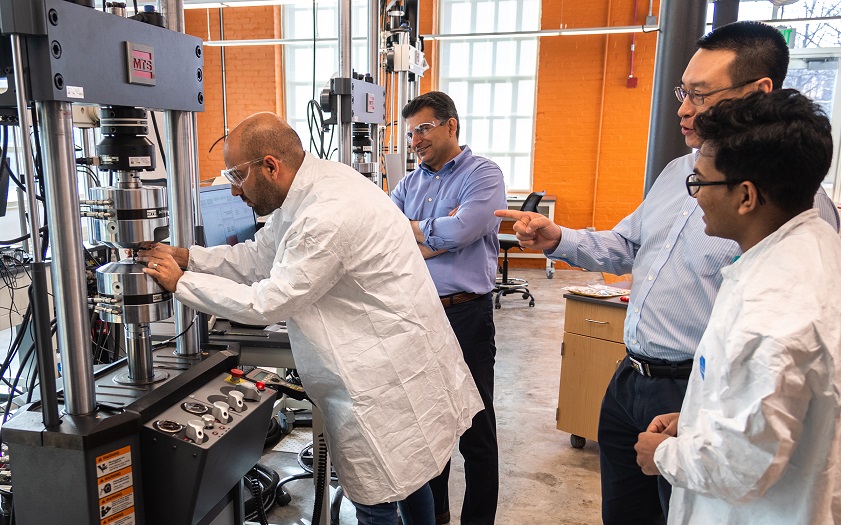
Auburn University is ranked in the top 11% of U.S. research institutions, coming in at No. 100 among 915 universities, according to the National Science Foundation’s recent Higher Education Research and Development, or HERD, Survey. Pictured, scientists in Auburn’s National Center for Additive Manufacturing Excellence conduct fatigue testing on an additively manufactured part.
Categories: Manufacturing, Energy & the Environment, Engineering, Auburn In the News, Advanced Systems, Agriculture
Auburn University expands research footprint in Huntsville with purchase of former LogiCore facility
Auburn University is expanding its footprint in the Huntsville area with the acquisition of a new research facility located in the Cummings Research Park.
The university reached an agreement with LogiCore Corp. to purchase two buildings with more than 40,000 square feet of space situated on a nine-acre parcel of land at 345 Voyager Way NW. Located within minutes of Redstone Arsenal’s Gate 9 entrance and near many of Auburn’s research partners in defense, aerospace, law enforcement and biotech sectors, the facility will significantly expand Auburn’s presence in the fastest-growing tech hub in the country, establishing a permanent foundation from which Auburn can leverage its regional reputation and thriving public-private partnerships into unprecedented national prestige and influence.
Designed to foster a new era of interagency and interdisciplinary collaboration necessary to secure the nation into the next century, the facility will serve as a state-of-the-art research space, collaboration engine and conference center that will focus Auburn’s expertise and next-generation resources on the defense, aerospace and law enforcement agencies that call Redstone Arsenal home.
“We are excited about the opportunities to expand our research capability in Huntsville, which is home to many members of the Auburn Family and our valued research partners,” said Auburn University President Jay Gogue. “We hope this facility will quickly become the primary connection for the Huntsville community to Auburn University and will be the go-to destination for government and industry entities around Redstone looking to meet in an unbiased, trusted location for technical interfacing.”
Plans for the facility include configurable laboratories for on-site research and development in critical technology areas; meeting spaces and engagement opportunities for government, industry and academia to allow for in-person and virtual meetings; exercises and more.
“This is a defining moment for Auburn University and the Huntsville community where today meets tomorrow,” said Jim Weyhenmeyer, university vice president for research and economic development. “This facility will fast-track connections that change the world through our valued research partnerships.”
LogiCore — a technology services company providing life cycle logistics, systems and software engineering, cybersecurity, information technology, programmatics and training services — operated the facility from 2015-22. Samples Properties acted as the university’s broker for this transaction.
“May the footprint be used to advance research excellence for students for years to come,” said Miranda Frost, LogiCore founder and CEO.
Media Contact: Austin Phillips, adp0019@auburn.edu, 334.844.2444
BY AUSTIN PHILLIPS
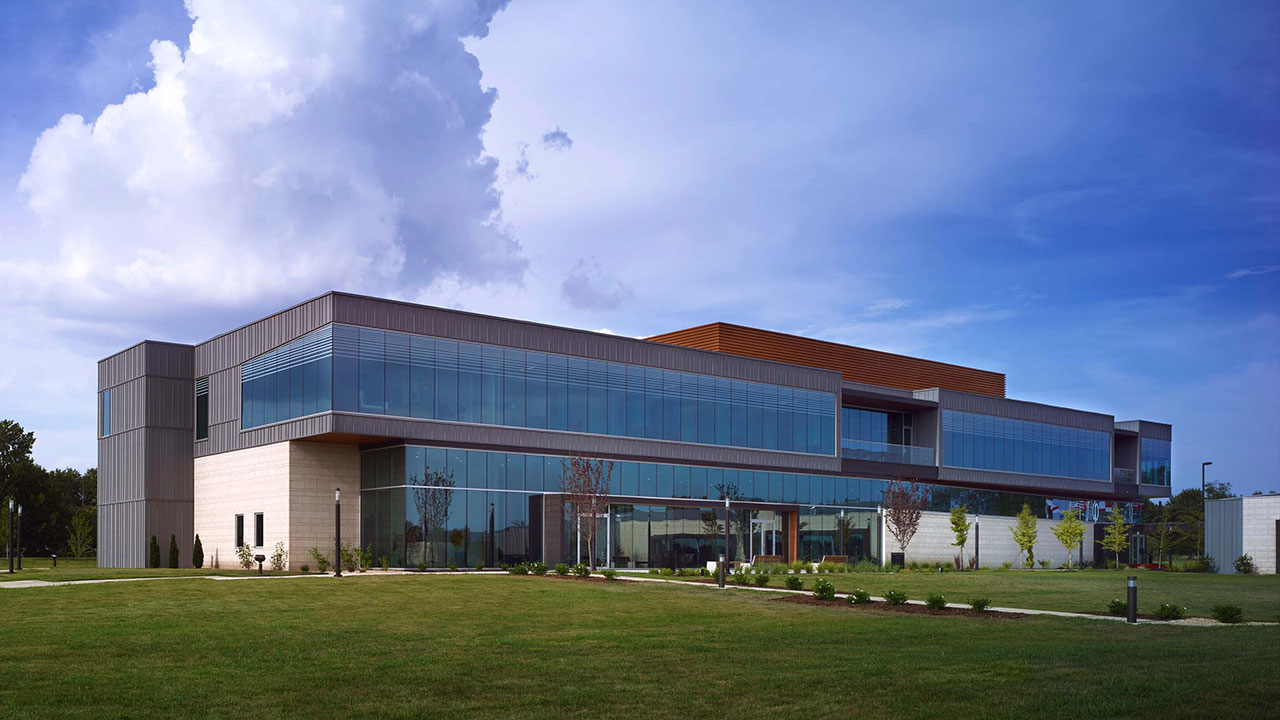
The 40,000 square-foot facility is located within minutes of Redstone Arsenal.
Categories: Manufacturing, Cyber, Security, Engineering
Chemical engineering professor becomes Auburn’s first senior member of National Academy of Inventors
Jin Wang is the first faculty member at Auburn University to be named a senior member of the National Academy of Inventors, or NAI.
The Walt and Virginia Woltosz Professor in Auburn’s Samuel Ginn College of Engineering is also Auburn’s first female faculty member to be named a senior member or a fellow of NAI. Since starting its fellows program in 2013, NAI has named seven Auburn faculty members to its esteemed list; all seven are male. Fa Foster Dai, the Godbold Endowed Chair Professor in the Department of Electrical and Computer Engineering, joined the 2021 fellows’ class.
“It’s wonderful to be recognized as an inventor and, in particular, a female inventor,” said Wang, who has been a part of the Department of Chemical Engineering since 2006. “I hope this will encourage female students to pursue technology innovation.”
Wang joins 82 other academic inventors from 41 research universities as part of the 2022 senior membership class. They are named inventors on more than 1,093 issued U.S. patents. Wang is also one of 40 female and/or minority inventors in the class.
Wang’s research innovations center around effectively converting waste into value-added products. In particular, she focuses on using a novel microbial coculture to convert agriculture waste-derived biogas into bioplastic feedstock. This method has shown great potential to reduce greenhouse gas emission and water and land pollution.
Throughout her academic career, Wang’s expertise in biogas conversion and sustainable food production have earned her national and international recognition, and her technological innovations have resulted in numerous patents granted by the U.S. Patent and Trademark Office.
“I hope and believe that our research will open new doors to greatly improve the sustainability of U.S. food production and help promote the transition of the current linear food production model (take-make-dispose) into a sustainable, circular and bio-based economy that minimizes, or even eliminates, waste generation,” she said.
NAI senior members are active faculty, scientists and administrators from NAI member institutions who have demonstrated remarkable innovation producing technologies that have brought, or aspire to bring, real impact on the welfare of society.
BY CASSIE MONTGOMERY
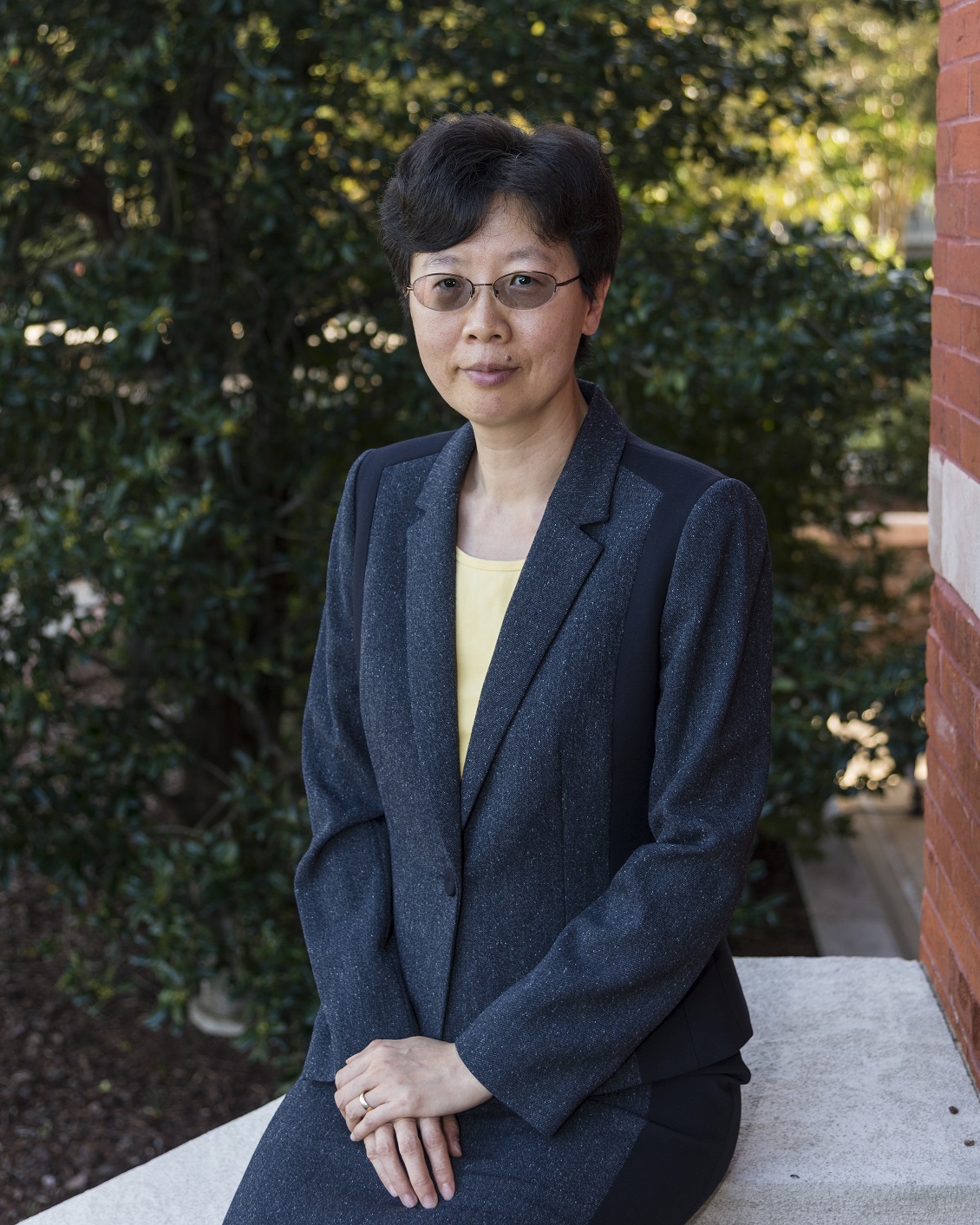
Jin Wang, the Walt and Virginia Woltosz Professor in Auburn’s Samuel Ginn College of Engineering, is the first Auburn faculty member to be named a senior member of the National Academy of Inventors.
Categories: Manufacturing, Energy & the Environment, Engineering, Agriculture
Interdisciplinary research team receives NSF grant to develop waste-reducing, biodegradable paper electronics
Current electronics and electronics device printing technologies rely on wet processes such as screen or inkjet printing that require extensive development of inks or solutions with limited sources of functional materials. These inks are often impure, incompatible with biodegradable paper substrates, and printed on eco-unfriendly plastics leading to a huge amount of electronic waste (or E-waste).
Masoud Mahjouri-Samani, the principal investigator and assistant professor in electrical and computer engineering, and a team of scientists representing multi-disciplinary units and centers from Auburn University were awarded a $499,940 grant by the National Science Foundation for their project, “Multi-material Manufacturing of Eco-Friendly and Biodegradable Paper-Based Flexible Hybrid Electronics.”
Co-principal investigators are Shuai Shao, associate professor in mechanical engineering, Nima Shamsaei, Philpott-WestPoint Stevens Distinguished Professor in mechanical engineering and Director of the National Center for Additive Manufacturing Excellence (NCAME), and Michael C. Hamilton, James B. Davis Professor in electrical and computer engineering and director of the Alabama Micro/Nano Science and Technology Center (AMNSTC).
“The team’s extensive expertise in theory and computation, additive manufacturing, mechanical reliability, and micro/nanoelectronics, not only guarantees the success of this research but also opens up a new opportunity for future collaborative activities,” said Shao.
Hamilton believes the infrastructure is well suited for such research activities. “The AMNSTC provides valuable scientific and technical expertise as well as international visibility to this work,” he added. “AMNSTC also provides access to a wide variety of electronic device fabrication and characterization instrumentation that allows us to test the functionality of our printed devices.”
“We are definitely excited about this interdisciplinary research activity among the NCAME, AMNSTC, as well as the departments of Electrical and Computer Engineering and Mechanical Engineering at Auburn University,” said Shamsaei. “At NCAME, most of our capabilities lie in fabricating metallic materials with micro-level accuracy. This research is not only a new addition to the center’s activity and field of additive manufacturing but also can potentially grow into a new field of Functional Additive Nanomanufacturing here at Auburn.”
The team’s research demonstrates a transformative dry additive nanomanufacturing approach that enables the printing of eco-friendly papertronics. Currently, substrates in use are made of polymers, which never decompose.
“What are you going to do with those products, many of which are designed for specific short-term tasks such as smart package labeling and sensors, once you have used them?” Mahjouri-Samani asked. “Throw them away, right? But, again, they don’t decompose. They aren’t biodegradable because they aren’t printed on biodegradable substrates such as paper. We can help prevent a huge waste problem.”
How can electronics and sensors be printed on biodegradable papers? The team has that answer, too.
“We have designed and developed the first printer in the world that can print on any substrate,” said Mahjouri-Samani, who dubbed this creation an “additive nanomanufacturing printer.”
This printing method is based on what he deems an “in-situ and on-demand” generation of nanoparticles by pulsed laser ablation of target materials at atmospheric pressure and at room temperature. These nanoparticles flow out of a nozzle creating a stream of nanoparticles. A substrate is then placed under the nozzle on a programmable X-Y-Z stage where these nanoparticles can be laser sintered (compacted into a solid mass) and crystallized in real-time to form desired patterns and devices.
“Overall, our additive nanomanufacturing process is capable of printing a wide range of dry, contamination-free, multi-layered, and intrinsically pure structures,” he added. “This approach also offers the flexibility of printing onto different types of substrates, including metals, ceramics, plastics, paper and flexible substrates such as thermoplastic polymers.”
Mahjouri-Samani said the primary purpose of this research effort is “to make a positive impact on humanity. We want planet Earth to be as clean as possible for this generation, and generations to follow,” he added. “If we can develop another way to reduce waste, then we are making a positive difference.”
Media Contact: Joe McAdory, jem0040@auburn.edu, 334.844.3447
BY JOE McADORY
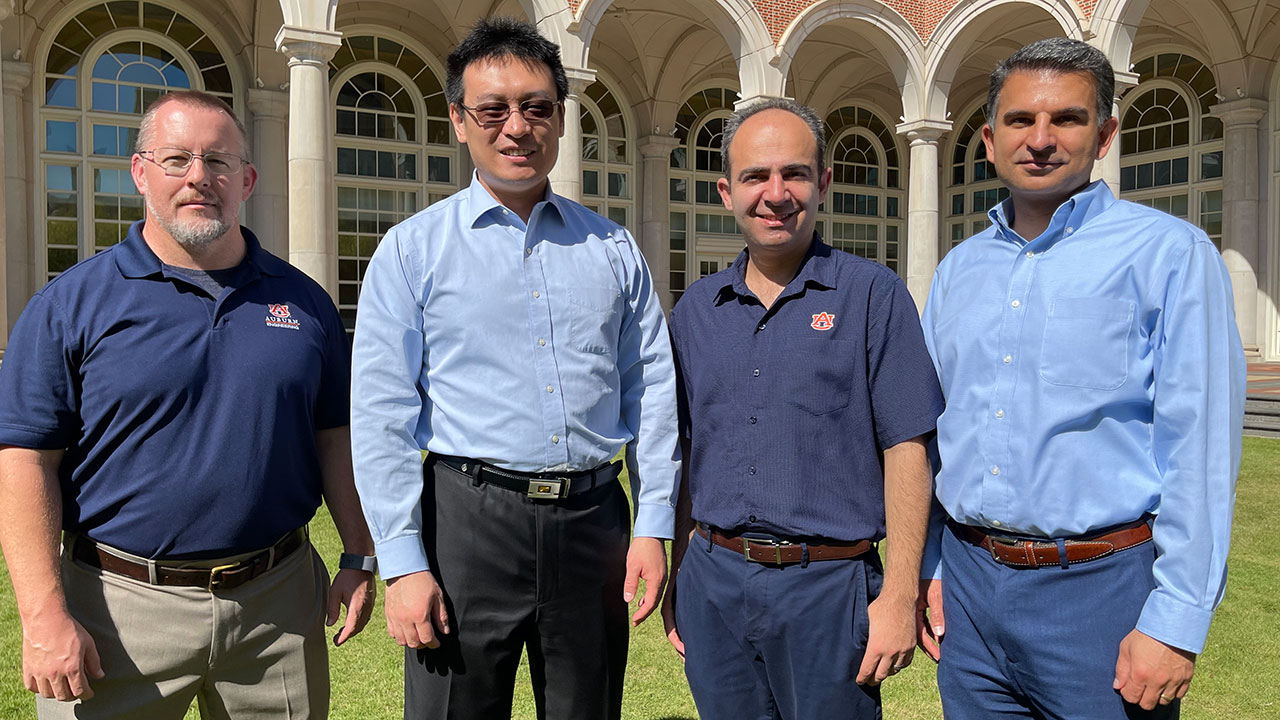
From the left: Michael C. Hamilton, Shuai Shao, Masoud Mahjouri-Samani and Nima Shamsaei.
Categories: Manufacturing, Engineering, Advanced Systems
USDA grants Auburn engineers $500K for timber, steel structure research
Four Auburn Engineering professors from three different disciplines will research the best way to design a sustainable, economically feasible building structure using timber and steel thanks to nearly $500K in federal and industry funds, including $237,000 from the USDA Forest Service Wood Innovations Grant program.
The goal of the project is not only to provide an environmentally friendly construction option but also a structurally efficient and widely applicable building method.
According to Kadir Sener, assistant professor of civil and environmental engineering and co-principal investigator on the project, steel and timber are ideal structural partners. The combination of steel and timber have a degree of structural performance that the individual materials could never reach, he said.
“In order to open the market for mass timber, we wanted to use it with steel structures, since timber alone is not economically feasible for high-rise buildings,” Sener said. “We ended up designing a very sustainable construction system, too.”
The current construction practice for mid-rise steel frame buildings uses 60-70% of the overall material in the floor alone. Additionally, most of the material used is concrete — an inexpensive, yet environmentally detrimental material which leaves a substantial carbon footprint. For this reason, cross-laminated timber panels will replace the concrete in this new design.
“Southern pine, the species that we are going to be using, is stronger than most other species of wood commonly used,” said David Rouche, assistant professor of civil and environmental engineering and specialist in the cross-laminated timber (CLT) component of the project. “It grows quickly, it's abundant in the southeast and the industry is growing so there is a lot of great potential for it in regards to this project.”
Replacing concrete floor elements with CLT panels has numerous advantages, such as significant reduction in structure weight, which will reduce gravity and seismic demands, reducing the carbon footprint by eliminating cement production and replacing time-consuming concrete field work. Additionally, it offers more convenient repair methods, providing more favorable structural performance and being a more sustainable option during repurposing or deconstruction.
The industry partners providing financial and technical support for the project include American Institute of Steel Construction, the Softwood Lumber Boards, the American Wood Council and Simpson Strong-Tie.
Media Contact: Jeremy Henderson, jdh0123@auburn.edu, 334-844-3591
BY VIRGINIA SPEIRS
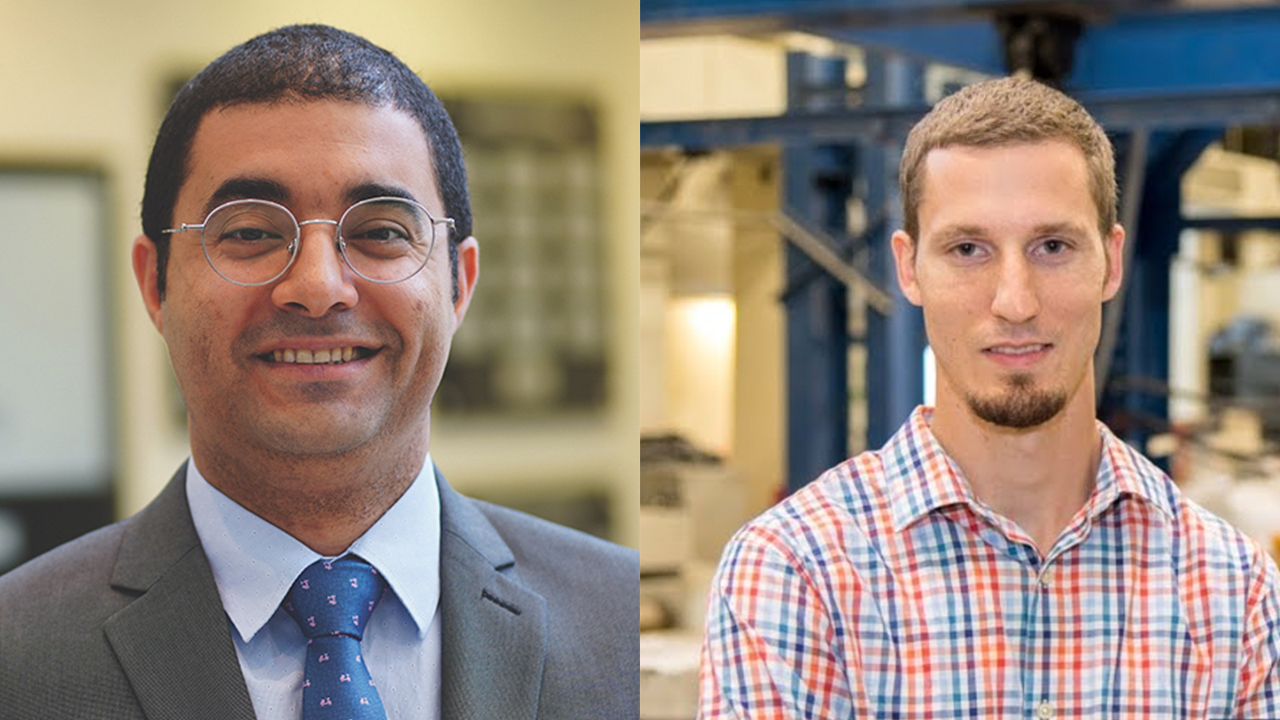
Pictured from the left: Kadir Sener and David Roueche
Categories: Manufacturing, Energy & the Environment, Engineering
Auburn to expand Industry 4.0 research, education, training and innovation capabilities with $7.2M DoD award
The Interdisciplinary Center for Advanced Manufacturing Systems (ICAMS) at Auburn University is the recipient of a $7.2 million award from the Department of Defense’s (DoD) Office of Industrial Policy’s Industrial Base Analysis and Sustainment (IBAS) Program to encourage small and medium-sized manufacturers to adopt the advanced technologies associated with Industry 4.0, or smart manufacturing. The award will allow the center to increase efforts to improve the skills of the next generation of engineers and the existing workforce to take full advantage of those technologies in their operations.
“With this award, we are building upon our original mission and expanding our research and services in key areas,” said Gregory Harris, ICAMS director and associate professor in the Samuel Ginn College of Engineering's Department of Industrial and Systems Engineering.
Gregory Purdy, assistant professor of industrial and systems engineering, is a co-principal investigator on the award and an ICAMS collaborating faculty member. He explained that one new focus of the funding will be devoted to the creation of the nation’s first cyber-physical manufacturing range (CpMR) housed on a university campus. The CpMR will provide a testbed to research, test, demonstrate and teach the technologies and processes to significantly improve technology adoption in small and medium-sized manufacturers and overcome the fear of malicious cyber activity in their systems.
“Industry 4.0 driven manufacturing environments are a collection of different equipment and technologies that increase the potential attack surface for malicious cyberattacks,” Purdy explained. “We are trying to understand what vulnerabilities exist in these systems and the potential impacts of a cyberattack on both the process and resulting part. However, it is not feasible to simulate attacks on a production resource that is used day-in and day-out.”
The CpMR solves this dilemma by incorporating modern manufacturing technologies in an Industry 4.0 ecosystem with current generation automation, thereby allowing a safe environment for testing and evaluating malicious cyber activity in an Industry 4.0 smart manufacturing platform.
“It allows students, researchers and other professionals to execute attacks and see what the outcome is in a state-of-the-art machining cell,” Purdy said. “I could unleash the most potent and sophisticated attack that I have and completely make everything go haywire, without endangering a key production resource.”
The new funding will also support the purchase of additional manufacturing equipment to further develop an Industry 4.0 manufacturing environment, including the creation of a digital manufacturing demonstration cell. The manufacturing and metrology cell will demonstrate the full digital manufacturing process flow starting by automatically scanning a subject and creating a point cloud from the 3D scan that is converted into a solid model. This model will be sent to a vertical machining center that will produce the part. A robotic arm will remove the part from the mill and deliver it to a coordinate measurement machine. The automated inspection process will then confirm the part matches the reference design. The digital manufacturing demonstration cell will be able to continuously run a product and show the capability of the connected enterprise.
“This additional equipment is going to make us more capable and allow us the ability to better showcase digital manufacturing demonstrations on site,” Harris explained. “We can show that this artifact can go all the way from design through production with little to no human intervention, really highlighting digital manufacturing capabilities. Manufacturers will be able to relate to that and say, ‘if they can do that with this artifact, I can envision what I’m trying to do using this technology.’”
According to Harris, another of those key areas of service is a “Path to the Plains” partnership with Southern Union State Community College (SU), where SU students can take Auburn University courses while completing their associate degree. The partnership also outlines a plan for a graduate certificate in advanced manufacturing and an advanced manufacturing minor. Additionally, any Auburn undergraduate student will be able to obtain a certificate in mechatronics through the partnership with SU. Participating students will be assisted by scholarships to support their educational success.
“The ability at ICAMS to create tailored programs upon request from industry allows local industries to adapt to changing industry trends much more easily using existing personnel,” said Lewis Payton, ICAMS associate director and professor of practice in the Department of Industrial and Systems Engineering. “Auburn students in the new manufacturing minor will also be graduating with hands-on experience using industrial grade equipment. ICAMS is poised to become the premier fabrication and teaching laboratory in the Southeast, including future expansion into the area of die fabrication and repair.”
Other ICAMS services that will be introduced or enhanced with this recent award include:
- An annual call for undergraduate and graduate research proposals to be evaluated and awarded to those that expand the demonstration, education training and research capabilities of ICAMS.
- Research into inspection technologies to understand how to provide real-time quality data as feedback to adjust equipment controls to continuously improve control limits and reduce the possibility of a defective product.
- The creation of a smart cyber-physical sensing, modeling and control digital twin infrastructure with augmented and mixed reality.
- The extension of annual survey research for three additional years, for a total of a five-year study into technology adoption amid small and medium-sized manufacturers.
“ICAMS represents a major, transformational change in the areas of outreach, innovation and education at Auburn University,” Payton said. “By early in 2022, ICAMS will be the most capable prototyping laboratory within the state of Alabama for innovation, creating a unique opportunity for companies and for student design teams across the campus.”
Adele Ratcliff, director of the DoD IBAS program which is funding the effort, commended the ICAMS project’s goal of reducing the barriers against Industry 4.0 technologies being implemented in small and medium manufacturing company operations.
“The ICAMS comprehensive approach of providing technical support, project planning, skilled workers and a way to test new technology’s real-life impact on production flows is a forward-leaning model that has been proven to overcome technology-adoption hesitancy in companies of all sizes,” Ratcliff said. “Larger manufacturers have the resources to fund these risk reduction activities on their own. By partnering with small and medium manufacturers, ICAMS allows these companies to have confidence that their technology implementation projects will provide valuable process and capability improvements with limited operational risk.”
ICAMS, which launched in 2018, has formed and strengthened relationships with the city of Auburn Industrial Development Board and the Alabama Community College System. Through these relationships, ICAMS has doubled its facility footprint from 10,000 square-feet to 20,000 square-feet, providing adequate space for its dedicated operations, and utilized the space to educate and train students and industry personnel to use the advanced manufacturing technologies and capabilities to benefit the DoD and its supporting manufacturing sector.
Media Contact: Cassie Montgomery, cmontgomery@auburn.edu, 334.844.3668
BY CASSIE MONTGOMERY
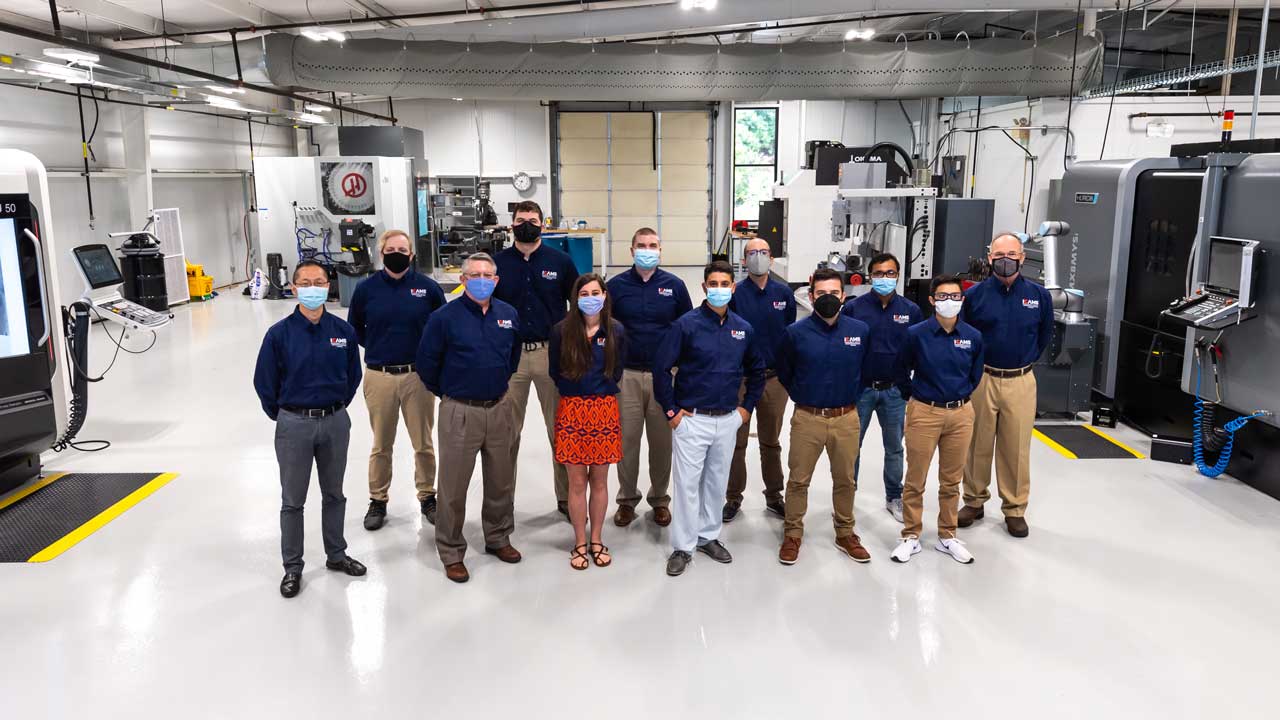
ICAMS collaborating faculty members and graduate students.
Categories: Manufacturing, Engineering, Advanced Systems
Auburn University researcher selected for NSF’s prestigious CAREER program, seeks to address critical societal issues with new products from engineered biomass
Maria Soledad Peresin, assistant professor of forest biomaterials in the Auburn University School of Forestry and Wildlife Sciences, has been selected for the prestigious National Science Foundation Faculty Early Career Development, or CAREER, program.
The CAREER Program is a foundation-wide activity that offers the NSF’s most prestigious awards in support of early career faculty who have the potential to serve as academic role models in research and education and to lead advances in the mission of their department or organization. Applicants must be untenured assistant professors at the time of application.
Funding for Peresin’s research, which began in April and will last five years, is expected to total $691,619.
Peresin—recently promoted to associate professor with tenure, effective this fall—aims to unlock the potential of certain components of plant or animal biomass to design engineered biomaterials. To do this, she will work to advance the fundamental understanding of naturally occurring systems to address critical societal issues, such as the removal of emerging contaminants from drinking water.
“I am delighted to be one of the 2021 NSF CAREER Award recipients,” Peresin said. “The proposal was a lot of work, but it was worth every bit of effort in terms of the doors that this grant opens to us. I certainly consider this achievement to be a reward to my entire research team, to whom I am very grateful. Without their hard work, resilience and professionalism, I would have not been able to establish this program.”
At Auburn’s Forestry Products Development Center, or FPDC, Peresin’s multidisciplinary research team gathers expertise in chemistry, pharmacy, materials sciences, engineering and product development to stimulate ideas for new businesses in food, pharmaceutical, biotechnology and medical sectors. The team achieves this through the development of novel value-added product development from biomass—including wood, annual crops, agro-forestry and sericulture, among others—focusing on surface modification of nanocellulose fibers for water remediation, macromolecules immobilization and developing composite materials using biobased polymers.
This project will focus on developing and using renewable, natural polymers—chemicals composed of the building blocks of smaller repeating molecules—to design efficient and sustainable absorbents, which are highly porous structures for the removal of contaminants such as antibiotics, analgesics and herbicides from water bodies. Natural polymer systems are inexpensive and could lead to more affordable filtration systems across the globe—increasing the economic impact of this research.
“There is still a lot to do and learn, but this award certainly gives my research program a great boost,” she said.
This program also provides her with an impactful platform for education and contributing to improved science literacy in Alabama. Peresin has established a successful mentoring program within Auburn University that involves internships and exchange programs with Tuskegee University and international institutions, such as the University of British Columbia and KU Leuven of Belgium for both undergraduate and graduate-level students.
Peresin is also a founding faculty member of the Sustainable Biomaterials and Packaging, or BIOP, program at Auburn, which provides another forum for disseminating information, recruiting new students and informally educating others on the utilization of bio-based materials, including its use to address water quality issues.
“This award is a game changer in many aspects, not only for the prestige, but also because of the unique nature of this five-year funding,” Peresin said. “This will allow me to focus on developing my research program in alignment with my education and outreach efforts toward increasing opportunities in STEM for underrepresented minorities.”
Peresin has partnered with Professor Becky Barlow, the school’s Alabama Extension coordinator and the Harry E. Murphy Professor, to disseminate the outcomes of her work through outreach events such as the yearly ForestHER workshop, an educational program for female forest landowners. Additionally, she will work with Auburn High School teachers on developing specific modules to be included in advanced placement biology and environmental sciences classes, with the aim of making them available to the entire state of Alabama through the Alabama Science in Motion program.
Janaki Alavalapati, dean of the School of Forestry and Wildlife Sciences, said Peresin is at a stage in her career to expand and strengthen the programs with which she is involved through the NSF CAREER Award.
“Dr. Peresin cares about students, their progress and their well-being,” Alavalapati said. “She is a co-lead to promote diversity and inclusion in the school, and her colleagues view her as being fully engaged in her profession and scientific organizations.
“She is the type of professor who climbs to the top of the ladder while being very humble and approachable. Her work is already making a difference in the lives of students and citizens of this country and beyond.”
The NSF CAREER Award opens new doors for both new and existing developments, an exciting prospect for Peresin and those who work with her.
“This funding will enable the consolidation of already established partnerships with national and international research groups and will take the quality of the research we conduct at the FPDC to the next level,” she said.
BY TERI GREENE
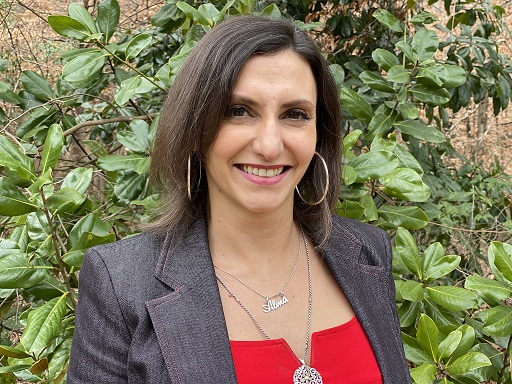
Maria Soledad Peresin, assistant professor of forest biomaterials in the Auburn University School of Forestry and Wildlife Sciences, has been selected for the prestigious National Science Foundation Faculty Early Career Development, or CAREER, program.
Categories: Manufacturing, Energy & the Environment
NSF grant to allow Auburn professors to study how nanomaterials disperse in liquids
As consumer electronics get smaller, the need for smaller parts, such as batteries, grows. Researchers are actively exploring additive manufacturing techniques to create the necessary smaller parts, but they first need to establish a fundamental understanding of the nanomaterial known as MXenes.
Virginia Davis, the Dr. Daniel F. and Josephine Breeden Professor of chemical engineering, and Majid Beidaghi, associate professor of materials engineering, are working to evaluate the properties of MXenes with a $328,420 National Science Foundation award for their project “Understanding the Effects of Sheet Size and Salt Addition on Aqueous MXene Dispersions: Phase Behavior, Rheological Properties and Printability.”
“MXenes are a new material and they have a lot of amazing properties and potential in applications such as batteries, supercapacitors and things that power our everyday devices,” Davis said. “However, in order to enable them to be used in these applications, we have to understand how to process them into different structures.”
MXenes are a family of 2D crystalline nanomaterials composed of transition metal carbides, nitrides or carbonitrides. One advantage of MXenes is that they can be dispersed in water and processed into devices and structures using fluid phase processing techniques such as direct ink writing, a specialized 3D printing technique. To date, advances in MXene processing have required time-consuming and expensive trial-and-error approaches.
“Our grant is looking at using fundamental tools for understanding how solids disperse in liquids and to gain new insight as to the behavior of (MXenes) to enable them to be printed into small devices using additive manufacturing,” Davis said. “In this grant we’re particularly looking at MXenes in the context of other 2D or sheet-like nanomaterials. If we can understand those fundamental principles that govern these sheet-like materials, then we can apply it to other new materials that we may discover or make materials we already know about, such as nanoclays, work even better.”
This topic represents a natural cross-section of Davis’ and Beidaghi’s specialized research areas. Beidaghi has studied MXenes and their potential since he was a post-doctoral research fellow at Drexel University. Davis is interested in understanding how to effectively process nanomaterials and how they flow in liquids.
“Really it was both of us coming together at Auburn that allowed us to tackle both parts of the problem, the materials chemistry part and the phase behavior part,” Davis said.
The two plan to collaborate with other researchers to advance the experimental and theoretical methods to study dispersions of nanomaterials.
Media Contact: Cassie Montgomery, cmontgomery@auburn.edu, 334.844.3668
BY CASSIE MONTGOMERY
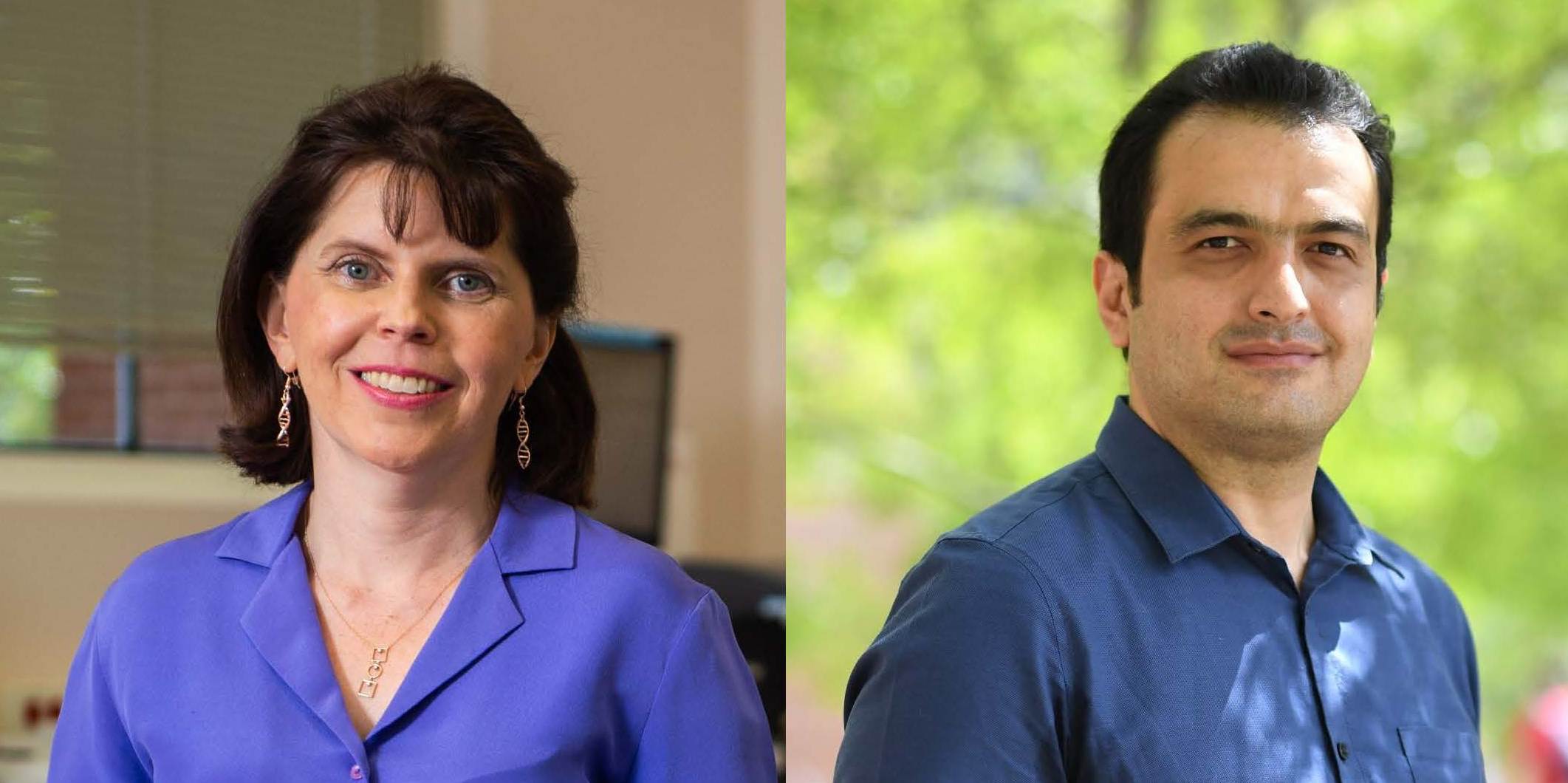
From the left: Virginia Davis and Majid Beidaghi
Categories: Manufacturing, Engineering, Advanced Systems
Auburn faculty members to research lead-free defense electronics as part of $7M award
Auburn University will soon help strengthen the economic and force posture of the United States’ lead-free defense electronics industrial base through participation in the newly-launched Defense Electronics Consortium (DEC).
The DEC was established by the U.S. Partnership for Assured Electronics through an award from the U.S. Department of Defense. The total award amount is expected to exceed $42 million – $7 million of which is expected to come to Auburn – and will be distributed during a period of five to seven years.
The first year of the project was funded at $3.9 million, with $830,000 awarded to Auburn Engineering. Auburn faculty will partner with researchers from Purdue University and the University of Maryland to focus on the Lead-Free Defense Electronics Project, the first initiative to flow through the DEC.
When compared to consumer electronics, defense electronics are subjected to harsher environments and are often designed for a much longer lifespan. Auburn faculty, led by principal investigator Sa’d Hamasha, assistant professor of industrial and systems engineering, will develop a comprehensive evaluation system for solder selection to meet specific defense-related requirements.
“The outcome of this research is a lead-free Solder Users Handbook to ensure a safe transition of aerospace and defense electronics to lead-free technology,” he said. “The lead-free project includes a plan for developing a comprehensive solder agnostic evaluation system for defense lead-free technology. The goal is to enable future new solders and electronics packaging technologies and processes for specific defense use cases.”
The interdisciplinary project is a collaboration between faculty in Auburn’s industrial and systems engineering and mechanical engineering departments. From the Department of Industrial and Systems Engineering, Hamasha will direct the research program, department chair John L. Evans is a co-principal investigator and will manage the USPAE consortium interface, and assistant professors Daniel Silva and Peter Liu are also co-principal investigators. Participating faculty from the Department of Mechanical Engineering include department chair and Quina Professor Jeffrey Suhling and professor George Flowers, Graduate School dean, as co-principal investigators. Emeritus professors Wayne Johnson from the Department of Electrical and Computer Engineering and Michael Bozack from the Department of Physics will also contribute.
“Auburn’s involvement comes after 25 years of excellence in electronics packaging, manufacturing and reliability and one of the largest research efforts in lead-free solder in the United States,” said Evans, the Charles D. Miller Chair Professor.
Hamasha explained that in addition to the Auburn team’s wealth of research experience, Auburn’s state-of-the-art facilities will be used to fill the gaps in thermal cycling, drop shock and vibration testing, all important factors to determining military suitability.
“Our team has experience investigating mechanical properties, failure and fatigue behavior and reliability of more than 50 standard and enhanced lead-free solder alloys, as well as the manufacturability of these materials,” Suhling said. “And our research has targeted mission critical electronic products for military, automotive, aerospace and industrial applications that are exposed to harsh environments.”
Overall, the work produced by the DEC has the potential to make a great impact in the defense industry.
“The DEC work will accelerate the use of advanced electronics technology for the defense industry, while also improving product quality, reliability, performance and reducing product costs,” Evans said.
Media Contact: Cassie Montgomery, cmontgomery@auburn.edu, 334.844.3668
BY CASSIE MONTGOMERY
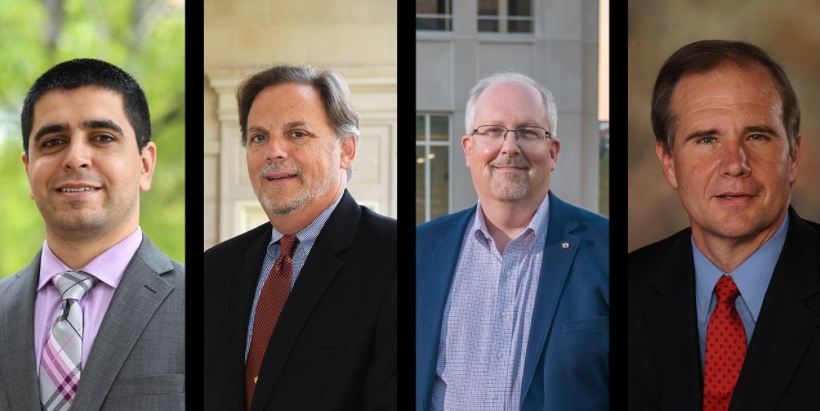 From left, Sa'd Hamasha, John L. Evans, Jeffrey Suhling and George Flowers
From left, Sa'd Hamasha, John L. Evans, Jeffrey Suhling and George Flowers
Categories: Manufacturing, Transportation, Engineering
Auburn University research projects among recipients of $2.57 million state award
Two Auburn University research projects are among the recipients of a $2.57 million award by the Alabama governor’s office to five of the state’s research institutions, Gov. Kay Ivey announced recently.
Brian Via and Beatriz Erramuspe, director and research fellow, respectively, of the Forest Products Development Center in the School of Forestry and Wildlife Sciences, were awarded $247,142 to research development of a paper-based device for a cost-effective method to detect dangerous formaldehyde emissions in wood panels.
Sabit Adanur, professor in the Department of Mechanical Engineering in the Samuel Ginn College of Engineering, was awarded $75,374 to conduct research relating to the design, fabrication and testing of novel medical face masks to prevent the spread of COVID-19 or future contagious viruses.
The grants are from the Alabama Research and Development Enhancement Fund, or ARDEF, a state-funded program created in 2019 under the Alabama Innovation Act and administered by the Alabama Department of Economic and Community Affairs, or ADECA.
The funding provides support and encourages new and continuing research that will result in products and services to improve the lives of Alabamians either from the products themselves or from new job opportunities.
“This funding from the Alabama Research and Development Enhancement Fund will help Auburn researchers continue to solve real-world problems through discovery and innovation,” said James Weyhenmeyer, Auburn’s vice president for research and economic development.
“The research being performed at our universities and institutions offers strong evidence that innovation is alive and well in Alabama," Ivey said when making the announcement. “These grants will help provide the needed resources to bring even more ideas and research to light, eventually resulting in new products and new job opportunities.”
Other institutions named in the award announcement include the Basham Institute of Science in Dadeville, Alabama, and various campuses of the University of Alabama. This is the second round of ARDEF funds awarded in this program in 2020.
Ivey earlier this year awarded $2.27 million in grants to state research institutions and programs. Three Auburn research projects were recipients in that earlier announcement.
BY MITCH EMMONS
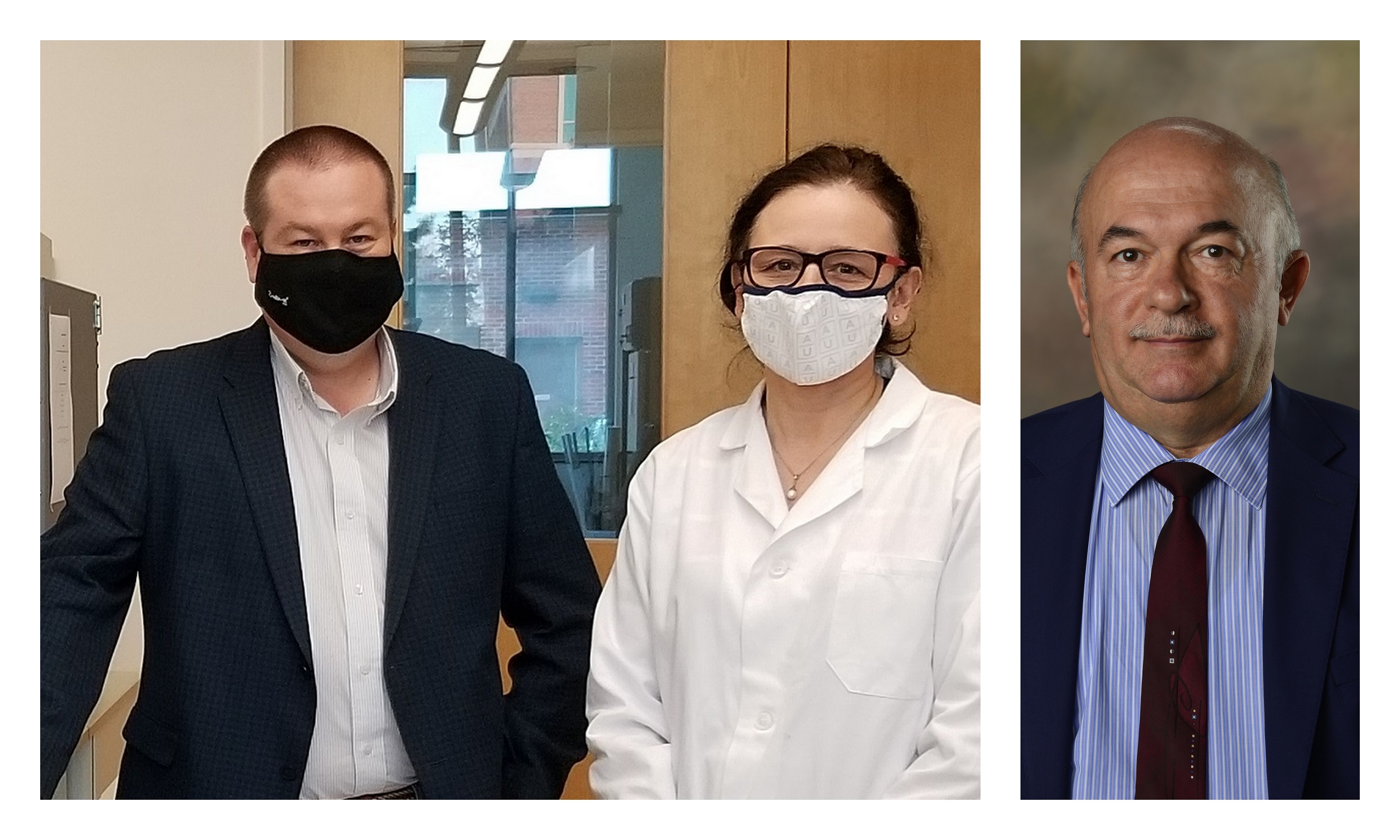
From the left: Brian Via, Beatriz Erramuspe and Sabit Adanur
Categories: Manufacturing, Health Sciences, Engineering, Auburn In the News
Auburn, UCLA faculty teaming up to develop micro-scale magnetic shields
An Auburn Engineering faculty member recently received a United States Office of Naval Research subcontract to work on a new technology that will use custom additively manufactured micro-scale shields to help protect electronics from magnetic fields, while also allowing integration of fiber optics for optical communication.
Michael Hamilton, the James B. Davis Professor of electrical and computer engineering and director of the Alabama Micro/Nano Science and Technology Center, will work with Systems Visions, a local company that provides engineering principles to design and develop structures, systems and processes, on new technologies to help shield sensitive superconducting electronic chips from magnetic fields while still allowing for signals to be sent and received through integrated fiber optics.
Hamilton will collaborate on this project with Robert Candler, professor of electrical and computer engineering at the University of California, Los Angeles. Hamilton and Candler graduated in the same class from Auburn University with bachelor’s degrees in electrical engineering in 2000.
“Interestingly enough, Rob is not just my colleague, but my friend who also went to Auburn at the same time I did,” Hamilton said. “We’ve been looking for a project to work on together for a while, so it was nice to find something that lined up both with what he’s working on and with what I’m working on.”
Hamilton said the duo are in phase one of the project with multiple challenges to overcome before a working prototype can be developed. Some challenges include engineering the technology to withstand ultra-cold temperatures around 4 Kelvin (-452 degrees Fahrenheit) and scaling down the integration of the fiber optics to about 10 millionths of a meter in diameter – 10 times smaller than a strand of hair.
“We’re characterizing these magnetic shields and making big strides in the steps toward building those little photonic structures,” Hamilton said. “Another piece of this project is observing how these micro-scale structures behave when we cool them down to a very low temperature and seeing if there’s a way we can engineer the interfaces and materials to perform better when you make it cold.”
Hamilton said he is confident that he and his team will work through the challenges of social distancing in the new normal with COVID-19 and that he is eager to contribute to the advancement of this technology under this subcontract.
“We’ve actually been really fortunate at Auburn where research can continue,” Hamilton said. “I know there are some places that had to just shut everything down, but we’ve been able to keep things going at a pretty good pace.”
BY VIRGINIA SPEIRS
Media Contact: Chris Anthony, chris.anthony@auburn.edu, 334.844.3447
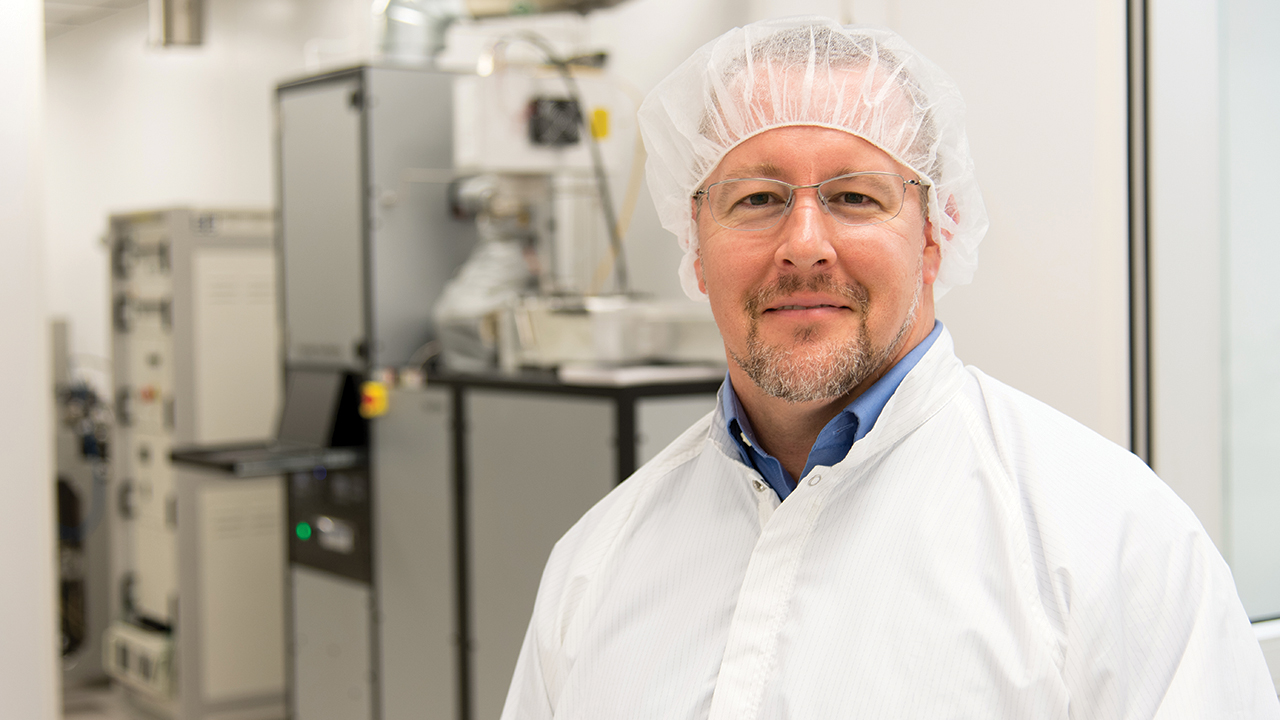 Michael Hamilton
Michael Hamilton
Categories: Manufacturing, Engineering, Advanced Systems
Auburn University Interdisciplinary Center for Advanced Manufacturing wins $4.26 million DOD award
The Interdisciplinary Center for Advanced Manufacturing Systems, or ICAMS, at Auburn University has received a $4.26 million award from the U.S. Department of Defense to explore the digitalization of manufacturing and become a resource for small and medium manufacturers throughout the country.
“The most significant way ICAMS can make a difference is in helping small and medium manufacturers understand the technologies they should be utilizing and helping them understand the need for adopting Industry 4.0/Smart Manufacturing concepts, therefore really digitalizing the full supply chain,” said Gregory Harris, ICAMS director and associate professor of industrial and systems engineering.
There is a growing digital divide between large manufacturers and the small- to medium-sized manufacturers that make up 85% of the industrial base in the United States. These large, original equipment manufacturers have blended their manufacturing physical and virtual domains into an Industry 4.0 environment, achieving positive productivity results. ICAMS researchers hope to help close this gap, in part by promoting advanced manufacturing principles to create a skilled workforce pipeline that starts in high school and continues through community college and beyond.
“The ideal student coming into this program is somebody who is a cross between a mechanical engineer, an industrial and systems engineer and a computer scientist. It’s a very interdisciplinary environment where, if you’re interested in computers and making things and realizing innovations, you will thrive. That’s the kind of student we’re looking for,” Harris said.
ICAMS is led by Harris and several additional faculty members from the Department of Industrial and Systems Engineering: assistant professor Peter Liu, assistant professor Konstantinos Mykoniatis, associate professor Lewis Payton and assistant professor Gregory Purdy. The center is also supported through a partnership with the City of Auburn’s Industrial Development Board, which has provided a facility to house large equipment and provide a hands-on learning laboratory for ICAMS students.
“Part of what we’re doing with ICAMS is helping develop the skill base and the skillsets needed so that the community college system and high schools can train students in the new technologies to be potential employees,” he explained. “We’re working with industry to train their current employees in these new capabilities and create a more effective system. Finally, we’re training engineers to be able to go out and help design, build and run these systems, thus ushering in the future of manufacturing.”
BY CASSIE MONTGOMERY
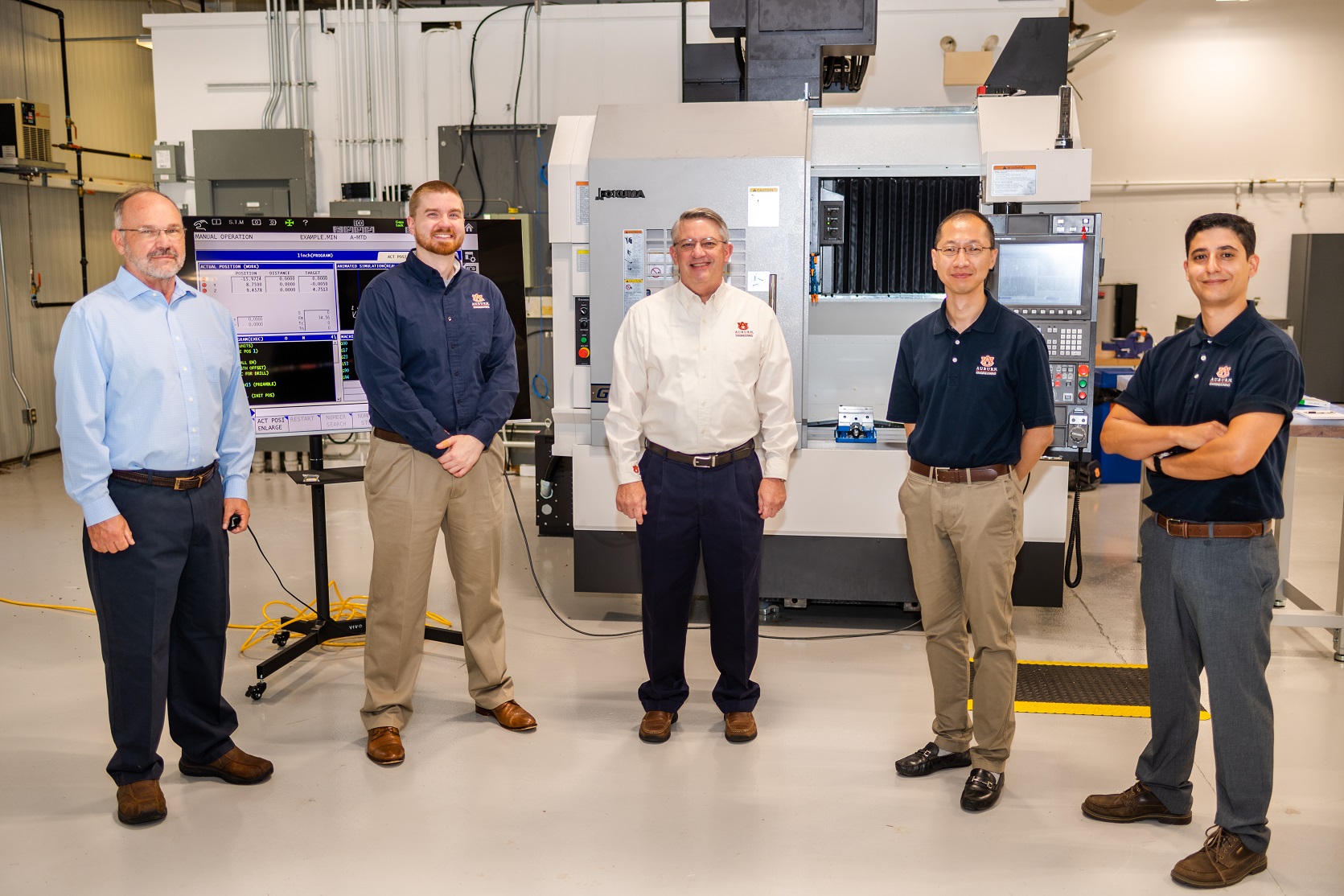 The Interdisciplinary Center for Advanced Manufacturing, or ICAMS, at Auburn University, housed within the Department of Industrial and Systems Engineering, is led by, from left to right, Lewis Payton, associate research professor; Greg Purdy, assistant professor; Greg Harris, ICAMS director and associate professor; Peter Liu, assistant professor; and Konstantinos Mykoniatis, assistant professor.
The Interdisciplinary Center for Advanced Manufacturing, or ICAMS, at Auburn University, housed within the Department of Industrial and Systems Engineering, is led by, from left to right, Lewis Payton, associate research professor; Greg Purdy, assistant professor; Greg Harris, ICAMS director and associate professor; Peter Liu, assistant professor; and Konstantinos Mykoniatis, assistant professor.
Categories: Manufacturing, Advanced Systems


